UNITED STATES
SECURITIES AND EXCHANGE COMMISSION
Washington, D.C. 20549
FORM 8-K
CURRENT REPORT
Pursuant to Section 13 OR 15(d)
of The Securities Exchange Act of 1934
Date of Report (Date of earliest event reported) June 25, 2024
TECTONIC THERAPEUTIC, INC.
(Exact name of registrant as specified in its charter)
| Delaware | 001-38537 | 81-0710585 | ||
| (State or other jurisdiction of incorporation) |
(Commission File Number) |
(IRS Employer Identification No.) |
| 490 Arsenal Way, Suite 210 Watertown, MA |
02472 | |
| (Address of principal executive offices) | (Zip Code) |
(339) 666-3320
(Registrant’s telephone number, including area code)
Check the appropriate box below if the Form 8-K filing is intended to simultaneously satisfy the filing obligation of the registrant under any of the following provisions (see General Instruction A.2.):
| ☐ | Written communications pursuant to Rule 425 under the Securities Act (17 CFR 230.425) |
| ☐ | Soliciting material pursuant to Rule 14a-12 under the Exchange Act (17 CFR 240.14a-12) |
| ☐ | Pre-commencement communications pursuant to Rule 14d-2(b) under the Exchange Act (17 CFR 240.14d-2(b)) |
| ☐ | Pre-commencement communications pursuant to Rule 13e-4(c) under the Exchange Act (17 CFR 240.13e-4(c)) |
Securities registered pursuant to Section 12(b) of the Act:
| Title of each class |
Trading Symbol |
Name of each exchange on which registered |
||
| Common Stock, par value $0.0001 per share | TECX | Nasdaq Global Market |
Indicate by check mark whether the registrant is an emerging growth company as defined in Rule 405 of the Securities Act of 1933 (§230.405 of this chapter) or Rule 12b-2 of the Securities Exchange Act of 1934 (§240.12b-2 of this chapter).
Emerging growth company ☐
If an emerging growth company, indicate by check mark if the registrant has elected not to use the extended transition period for complying with any new or revised financial accounting standards provided pursuant to Section 13(a) of the Exchange Act. ☐
| Item 7.01. | Regulation FD Disclosure. |
Tectonic Therapeutic, Inc. (the “Company”) has updated its corporate presentation for use in meetings with investors, analysts and others. A copy of the updated corporate presentation is furnished as Exhibit 99.1 to this Current Report on Form 8-K. Investors may access the presentation by visiting the “Events & Presentations” section of the Company’s investor website at https://investors.tectonictx.com.
The information furnished under this Item 7.01, including Exhibit 99.1, shall not be deemed “filed” for purposes of Section 18 of the Securities Exchange Act of 1934 (the “Exchange Act”) or subject to the liabilities of that section, nor shall it be deemed to be incorporated by reference into any of the Company’s filings with the Securities and Exchange Commission, regardless of any general incorporation language in such a filing.
| Item 8.01 | Other Events. |
Proposed TX000045 (“TX45”) Phase 2 Trial Design
As previously disclosed, the Company plans to initiate its Phase 2 randomized, placebo-controlled, double-blind proof-of-concept clinical trial to evaluate TX45 in patients with Group 2 Pulmonary Hypertension (“PH”) in the setting of Heart Failure with Preserved Ejection Fraction (“HFpEF”) in the second half of 2024.
The Phase 2 clinical trial is expected to be conducted globally, including at clinical trial sites in the United States, Europe, Eastern Europe and Australia. This trial is designed to enrich for patients with an increased pulmonary vascular resistance of greater than 3 on baseline right heart catheterization with the goal of evaluating efficacy in both Combined pre-and post-capillary Pulmonary Hypertension as well as the whole Group 2 PH population with HFpEF. The Company currently expects that approximately 180 subjects will enter the trial. Each subject will be randomized to one of two treatment arms or a placebo arm. The treatment period will last for 24 weeks and there will be a follow-up evaluation 8 weeks after the last dose.
Forward-Looking Statements
Statements contained in this Current Report on Form 8-K regarding matters that are not historical facts are “forward looking statements” within the meaning of the Private Securities Litigation Reform Act of 1995. The Company may, in some cases, use terms such as “predicts,” “believes,” “potential,” “proposed,” “continue,” “designed,” “estimates,” “anticipates,” “expects,” “plans,” “intends,” “may,” “could,” “might,” “will,” “should” or other words or expressions referencing future events, conditions or circumstances that convey uncertainty of future events or outcomes to identify these forward-looking statements. Such forward-looking statements include but are not limited to, expectations regarding the initiation, design, protocol and timing of the Company’s proposed Phase 2 clinical trial of Group 2 PH in the setting of HFpEF. Because such statements are subject to risks and uncertainties, actual results may differ materially from those expressed or implied by such forward-looking statements. Factors that contribute to the uncertain nature of the forward-looking statements include potential unforeseen events during clinical trials could cause delays or other adverse consequences; risks relating to the regulatory approval process; success in preclinical testing and earlier clinical trials does not ensure that later clinical trials will generate the same results or otherwise provide adequate data to demonstrate the efficacy and safety of a product candidate; the Company’s product candidates may cause serious adverse side effects; the Company’s reliance on third parties, including for the manufacture of materials for its research programs, preclinical and clinical studies; the ability of the Company’s need for additional funding, which may not be available; the impact of macroeconomic conditions, including the conflict in Ukraine and the conflict in the Middle East, heightened inflation and uncertain credit and financial markets, on the Company’s business, clinical trials and financial position; changes in the regulatory environment; the uncertainties and timing of the regulatory approval process; and unexpected litigation or other disputes. Other factors that may cause the Company’s actual results to differ from those expressed or implied in the forward-looking statements in this press release are identified under the heading “Risk Factors” in the final prospectus on Form 424(b)(3) filed by the Company with the SEC on May 3, 2024, and in other filings that the Company makes and will make with the SEC in the future. All forward-looking statements contained in this press release speak only as of the date on which they were made and are based on management’s assumptions and estimates as of such date. The Company undertakes no obligation to update any forward-looking statements, whether as a result of the receipt of new information, the occurrence of future events or otherwise, except as required by law.
| Item 9.01. | Financial Statements and Exhibits. |
| (d) | Exhibits |
| Exhibit No. | Description | |
| 99.1 | Corporate Presentation dated June 2024. | |
| 104 | Cover Page Interactive Data File (formatted as Inline XBRL). | |
SIGNATURES
Pursuant to the requirements of the Securities Exchange Act of 1934, the registrant has duly caused this report to be signed on its behalf by the undersigned hereunto duly authorized.
| TECTONIC THERAPEUTIC, INC. | ||||||
| Date: June 25, 2024 | By: | /s/ Daniel Lochner |
||||
| Daniel Lochner | ||||||
| Chief Financial Officer | ||||||
Exhibit 99.1
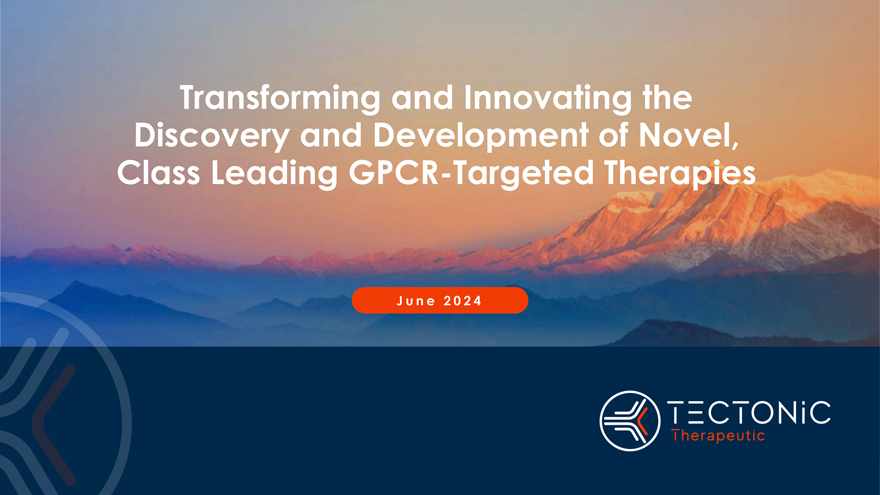
Transforming and Innovating the Discovery and Development of Novel, Class Leading GPCR-Targeted TherapiesJ u n e 2 0 2 4
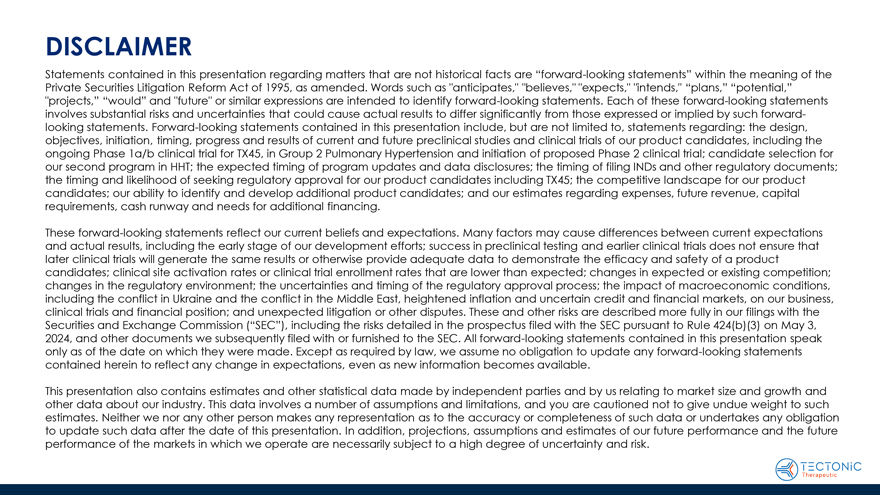
Transforming and Innovating the Discovery and Development of Novel, Class Leading GPCR-Targeted TherapiesJ u n e 2 0 2 4DISCLAIMERStatements contained in this presentation regarding matters that are not historical facts are “forward-looking statements” within the meaning of the Private Securities Litigation Reform Act of 1995, as amended. Words such as “anticipates,” “believes,” “expects,” “intends,” “plans,” “potential,”“projects,” “would” and “future” or similar expressions are intended to identify forward-looking statements. Each of these forward-looking statements involves substantial risks and uncertainties that could cause actual results to differ significantly from those expressed or implied by such forward-looking statements. Forward-looking statements contained in this presentation include, but are not limited to, statements regarding: the design, objectives, initiation, timing, progress and results of current and future preclinical studies and clinical trials of our product candidates, including the ongoing Phase 1a/b clinical trial for TX45, in Group 2 Pulmonary Hypertension and initiation of proposed Phase 2 clinical trial; candidate selection for our second program in HHT; the expected timing of program updates and data disclosures; the timing of filing INDs and other regulatory documents; the timing and likelihood of seeking regulatory approval for our product candidates including TX45; the competitive landscape for our product candidates; our ability to identify and develop additional product candidates; and our estimates regarding expenses, future revenue, capital requirements, cash runway and needs for additional financing. These forward-looking statements reflect our current beliefs and expectations. Many factors may cause differences between current expectations and actual results, including the early stage of our development efforts; success in preclinical testing and earlier clinical trials does not ensure that later clinical trials will generate the same results or otherwise provide adequate data to demonstrate the efficacy and safety of a product candidates; clinical site activation rates or clinical trial enrollment rates that are lower than expected; changes in expected or existing competition; changes in the regulatory environment; the uncertainties and timing of the regulatory approval process; the impact of macroeconomic conditions, including the conflict in Ukraine and the conflict in the Middle East, heightened inflation and uncertain credit and financial markets, on our business, clinical trials and financial position; and unexpected litigation or other disputes. These and other risks are described more fully in our filings with theSecurities and Exchange Commission (“SEC”), including the risks detailed in the prospectus filed with the SEC pursuant to Rule 424(b)(3) on May 3,2024, and other documents we subsequently filed with or furnished to the SEC. All forward-looking statements contained in this presentation speak only as of the date on which they were made. Except as required by law, we assume no obligation to update any forward-looking statements contained herein to reflect any change in expectations, even as new information becomes available. This presentation also contains estimates and other statistical data made by independent parties and by us relating to market size and growth and other data about our industry. This data involves a number of assumptions and limitations, and you are cautioned not to give undue weight to such estimates. Neither we nor any other person makes any representation as to the accuracy or completeness of such data or undertakes any obligation to update such data after the date of this presentation. In addition, projections, assumptions and estimates of our future performance and the future performance of the markets in which we operate are necessarily subject to a high degree of uncertainty and risk.
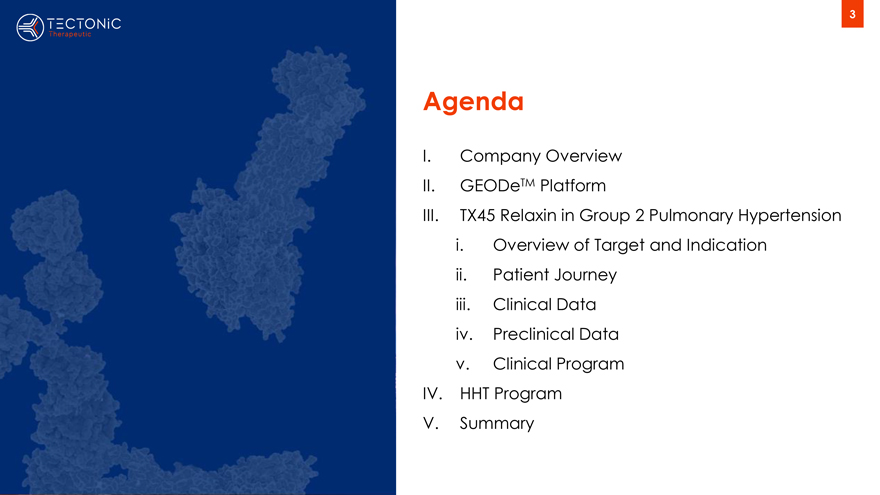
AgendaI. Company OverviewII. GEODeTM PlatformIII. TX45 Relaxin in Group 2 Pulmonary Hypertension i. Overview of Target and Indication ii. Patient Journey iii. Clinical Data iv. Preclinical Data v. Clinical ProgramIV. HHT Program V. Summary
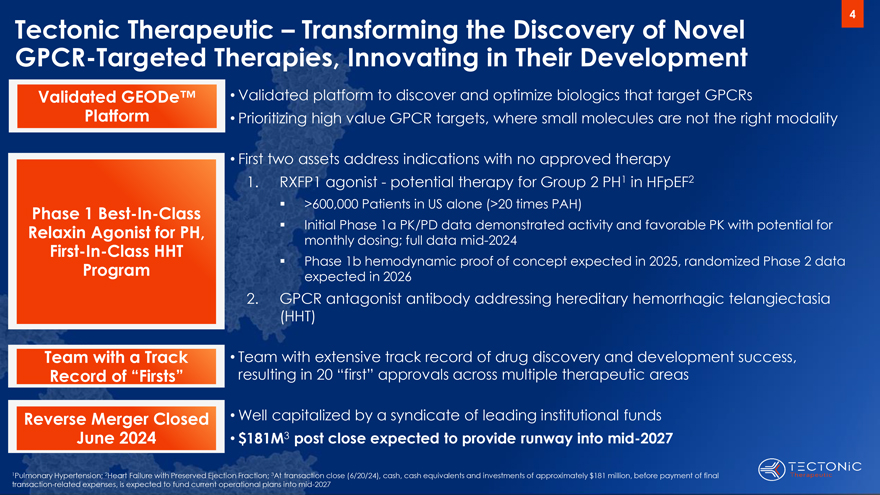
Agenda I. Company Overview II. GEODeTM Platform III. TX45 Relaxin in Group 2 Pulmonary Hypertension i. Overview of Target and Indication ii. Patient Journey iii. Clinical Data iv. Preclinical Data v. Clinical Program IV. HHT Program V. Summary4 Tectonic Therapeutic – Transforming the Discovery of Novel GPCR-Targeted Therapies, Innovating in Their Development Validated GEODe Validated platform to discover and optimize biologics that target GPCRsPlatform Prioritizing high value GPCR targets, where small molecules are not the right modality First two assets address indications with no approved therapy 1. RXFP1 agonist—potential therapy for Group 2 PH1 in HFpEF2 >600,000 Patients in US alone (>20 times PAH) Phase 1 Best-In-ClassRelaxin Agonist for PH, Initial Phase 1a PK/PD data demonstrated activity and favorable PK with potential for monthly dosing; full data mid-2024 First-In-Class HHT Phase 1b hemodynamic proof of concept expected in 2025, randomized Phase 2 data Program expected in 2026 2. GPCR antagonist antibody addressing hereditary hemorrhagic telangiectasia(HHT)Team with a Track Team with extensive track record of drug discovery and development success,Record of “Firsts” resulting in 20 “first” approvals across multiple therapeutic areas Reverse Merger Closed Well capitalized by a syndicate of leading institutional funds June 2024 $181M3 post close expected to provide runway into mid-2027 1Pulmonary Hypertension; 2Heart Failure with Preserved Ejection Fraction; 3At transaction close (6/20/24), cash, cash equivalents and investments of approximately $181 million, before payment of final transaction-related expenses, is expected to fund current operational plans into mid-2027
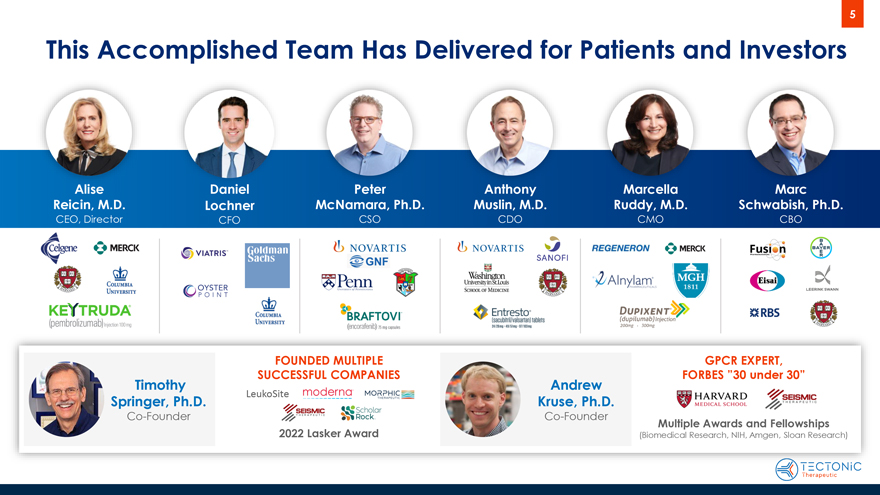
This Accomplished Team Has Delivered for Patients and Investors Reicin, M.D. Lochner McNamara, Ph.D. Muslin, M.D. Ruddy, M.D. Schwabish, Ph.D. CEO, Director CFO CSO CDO CMO CBO FOUNDED MULTIPLE GPCR EXPERT, SUCCESSFUL COMPANIES FORBES ”30 under 30” Timothy AndrewSpringer, Ph.D. LeukoSite Kruse, Ph.D.Co-Founder Co-Founder Multiple Awards and Fellowships 2022 Lasker Award (Biomedical Research, NIH, Amgen, Sloan Research)
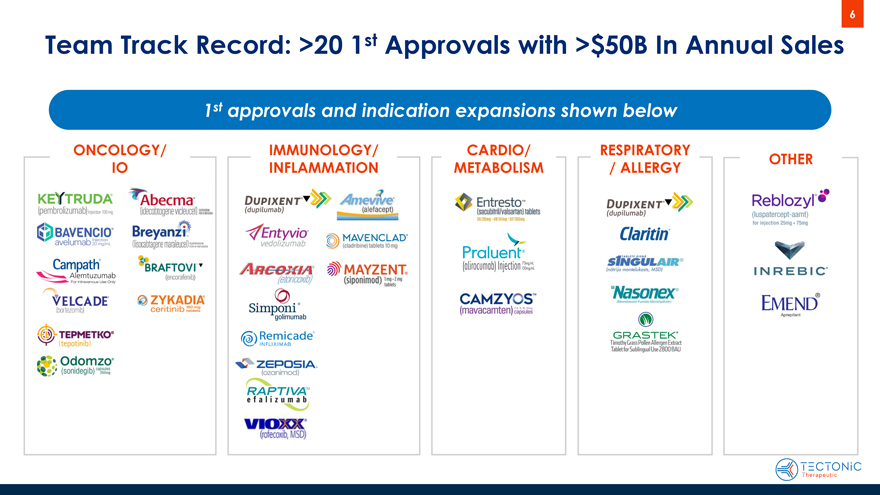
Team Track Record: >20 1st Approvals with >$50B In Annual Sales 1st approvals and indication expansions shown below ONCOLOGY/ IMMUNOLOGY/ CARDIO/ RESPIRATORY OTHER IO INFLAMMATION METABOLISM / ALLERGY
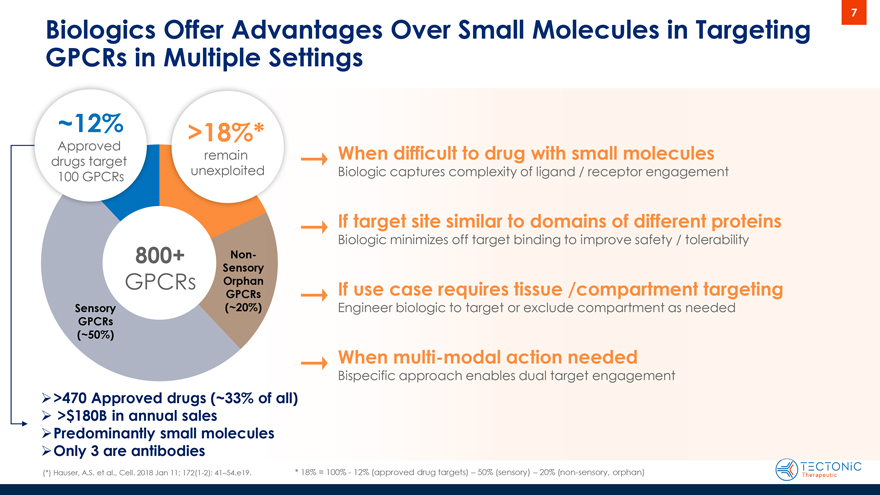
Biologics Offer Advantages Over Small Molecules in Targeting GPCRs in Multiple Settings ~12% >18%*Approveddrugs target remain When difficult to drug with small molecules 100 GPCRs unexploited Biologic captures complexity of ligand / receptor engagement If target site similar to domains of different proteins Biologic minimizes off target binding to improve safety / tolerability 800+ Non- Sensory GPCRs Orphan If use case requires tissue /compartment targeting GPCRs Sensory (~20%) Engineer biologic to target or exclude compartment as needed GPCRs (~50%) When multi-modal action neededBispecific approach enables dual target engagement >470 Approved drugs (~33% of all) >$180B in annual sales Predominantly small molecules Only 3 are antibodies (*) Hauser, A.S. et al., Cell. 2018 Jan 11; 172(1-2): 41–54.e19. * 18% = 100%—12% (approved drug targets) – 50% (sensory) – 20% (non-sensory, orphan)
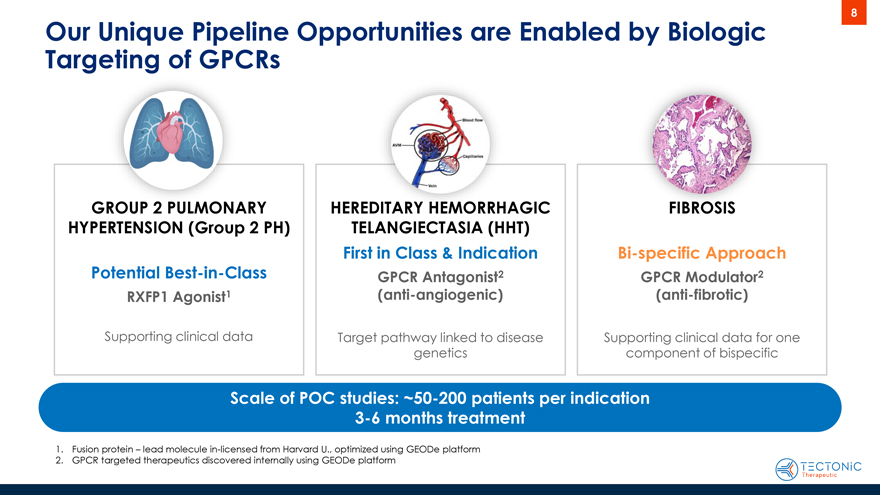
Our Unique Pipeline Opportunities are Enabled by Biologic Targeting of GPCRs GRO RY HEREDITARY HYPERTENSION (Group 2 PH) TELANGIECTASIA (HHT) First in Class & Indication Bi-specific Approach Potential Best-in-Class GPCR Antagonist2 GPCR Modulator2 RXFP1 Agonist1 (anti-angiogenic) (anti-fibrotic) Supporting clinical data Target pathway linked to disease Supporting clinical data for one genetics component of bispecific Scale of POC studies: ~50-200 patients per indication 3-6 months treatment 1. Fusion protein – lead molecule in-licensed from Harvard U., optimized using GEODe platform 2. GPCR targeted therapeutics discovered internally using GEODe platform
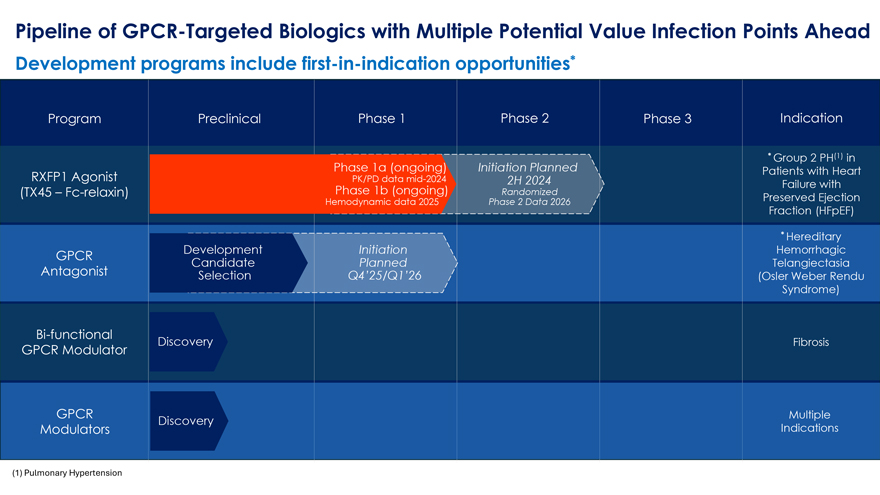
Pipeline of GPCR-Targeted Biologics with Multiple Potential Value Infection Points Ahead Development programs include first-in-indication opportunities*Program Preclinical Phase 1 Phase 2 Phase 3 Indication * Group 2 PH(1) in Phase 1a (ongoing) Initiation Planned Patients with HeartRXFP1 AgonistPK/PD data mid-2024 2H 2024 Failure with(TX45 – Fc-relaxin)Phase 1b (ongoing) Randomized Hemodynamic data 2025Phase 2 Data 2026 Preserved EjectionFraction (HFpEF) * Hereditary GPCR DevelopmentInitiation Hemorrhagic CandidatePlanned Telangiectasia Antagonist Selection Q4’25/Q1’26 (Osler Weber Rendu Syndrome) Bi-functionalDiscovery Fibrosis GPCR Modulator GPCR MultipleDiscovery Modulators Indications (1) Pulmonary Hypertension
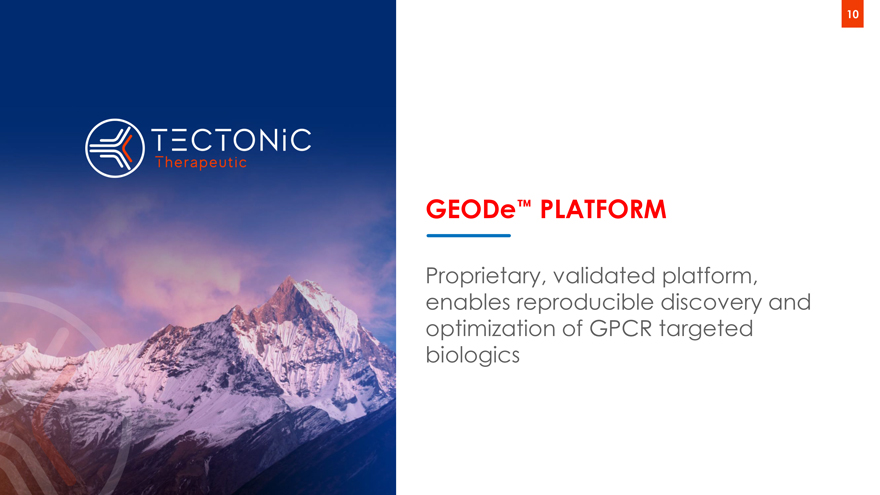
GEODe PLATFORM Proprietary, validated platform, enables reproducible discovery and optimization of GPCR targeted biologics
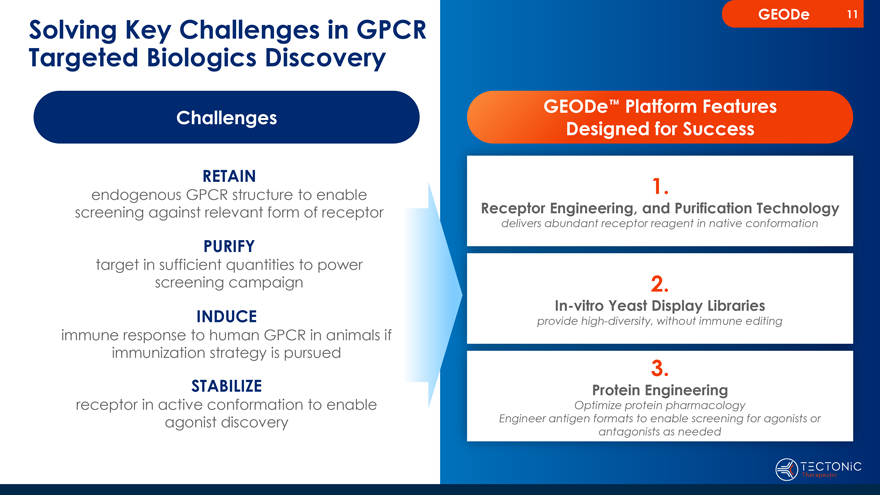
11 Solving Key Challenges in GPCR Targeted Biologics Discovery GEODe Platform Features Challenges Designed for Success RETAIN 1.endogenous GPCR structure to enable screening against relevant form of receptor Receptor Engineering, and Purification Technologydelivers abundant receptor reagent in native conformation PURIFY target in sufficient quantities to power screening campaign 2.In-vitro Yeast Display Libraries INDUCE provide high-diversity, without immune editing immune response to human GPCR in animals if immunization strategy is pursued 3.STABILIZE Protein Engineering receptor in active conformation to enable Optimize protein pharmacologyagonist discovery Engineer antigen formats to enable screening for agonists or antagonists as needed
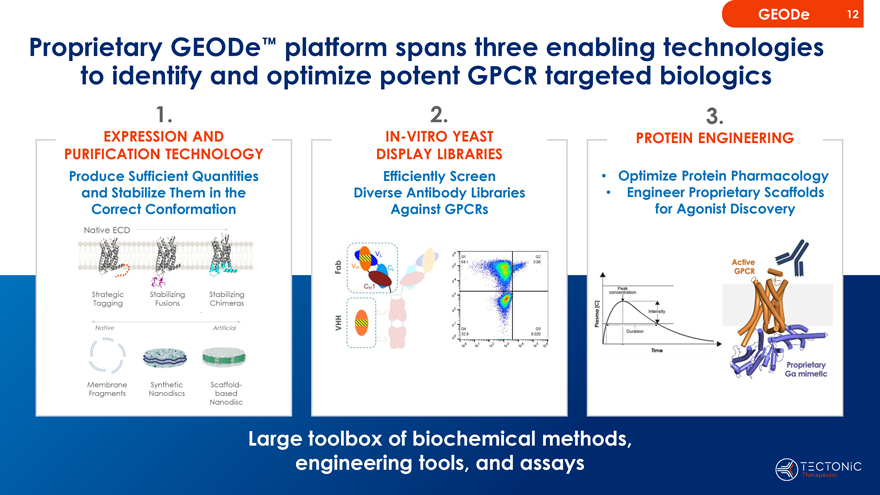
Proprietary GEOD platform spans three enabling technologies to identify and optimize potent GPCR targeted biologics 1. 2. 3.EXPRESSION AND IN-VITRO YEAST PROTEIN ENGINEERING PURIFICATION TECHNOLOGY DISPLAY LIBRARIES Produce Sufficient Quantities Efficiently Screen Optimize Protein Pharmacology and Stabilize Them in the Diverse Antibody Libraries Engineer Proprietary Scaffolds Correct Conformation Against GPCRs for Agonist Discovery Large toolbox of biochemical methods, engineering tools, and assays
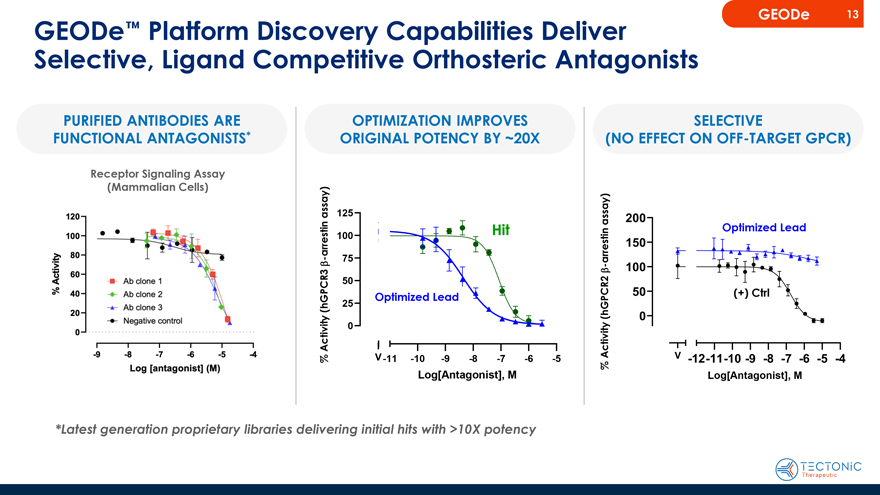
GEODe 13 GEOD Platform Discovery Capabilities Deliver Selective, Ligand Competitive Orthosteric Antagonists PURIFIED ANTIBODIES ARE OPTIMIZATION IMPROVES SELECTIVEFUNCTIONAL ANTAGONISTS* ORIGINAL POTENCY BY ~20X (NO EFFECT ON OFF-TARGET GPCR) Receptor Signaling Assay (Mammalian Cells) assay) 125assay) X786 200 Hit Optimized Lead 100 X774 y 150 arrestin—it ity v i 75 arrestin ï¢ - v t 100 Acï¢50 %Act % 50 (+) Ctrl Optimized Lead (hGPCR3 25(hGPCR2 0 Activity 0V Activity V % -11 -10 -9 -8 -7 -6 -5% -12-11-10 -9 -8 -7 -6 -5 -4 Log[Antagonist], M Log[Antagonist], M *Latest generation proprietary libraries delivering initial hits with >10X potency
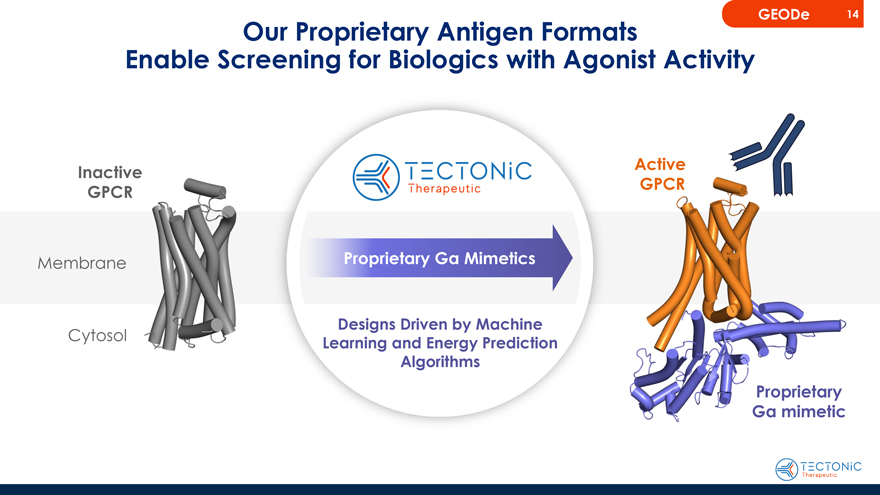
GEODe 14 Our Proprietary Antigen Formats Enable Screening for Biologics with Agonist Activity Active Inactive GPCR GPCR Membrane Proprietary Ga Mimetics Designs Driven by Machine Cytosol Learning and Energy Prediction Algorithms ProprietaryGα mimetic
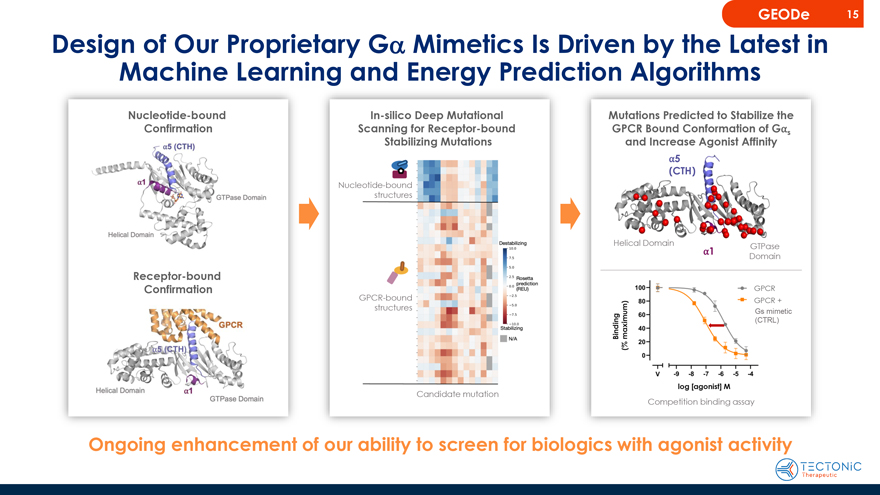
Design of Our Proprietary G Mimetics Is Driven by the Latest in Machine Learning and Energy Prediction Algorithms Nucleotide-bound In-silico Deep Mutational Mutations Predicted to Stabilize the Confirmation Scanning for Receptor-bound GPCR Bound Conformation of G Stabilizing Mutations and Increase Agonist Affinity 5 (CTH) Nucleotide-bound structures Helical Domain GTPa1 Domain Receptor-boundConfirmation GPCR GPCR-bound GPCR + structures Gs mimeticBinding maximum) (CTRL) (% Candidate mutation log [agonist] M Competition binding assay Ongoing enhancement of our ability to screen for biologics with agonist activity
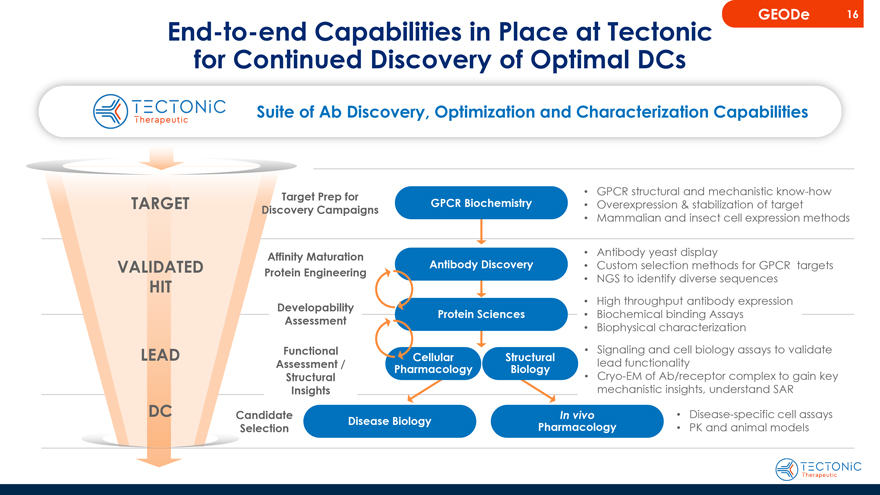
GEODe 16 End-to-end Capabilities in Place at Tectonic for Continued Discovery of Optimal DCs Suite of Ab Discovery, Optimization and Characterization Capabilities Target Prep for GPCR structural and mechanistic know-how TARGET GPCR Biochemistry Overexpression & stabilization of target Discovery Campaigns Mammalian and insect cell expression methods Affinity Maturation Antibody yeast display VALIDATED Antibody Discovery Custom selection methods for GPCRtargets Protein Engineering HIT NGS to identify diverse sequences High throughput antibody expression DevelopabilityProtein Sciences Biochemical binding Assays Assessment Biophysical characterization LEAD Functional Signaling and cell biology assays to validateCellular Structural Assessment / lead functionality Pharmacology Biology Structural Cryo-EM of Ab/receptor complex to gain key Insights mechanistic insights, understand SAR DC Candidate In vivo Disease-specific cell assays Disease Biology Selection Pharmacology PK and animal models
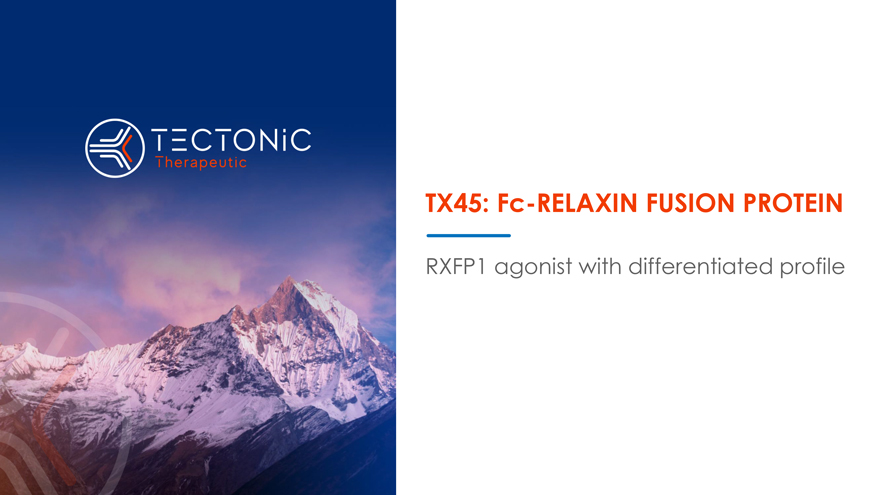
TX45: Fc-RELAXIN FUSION PROTEIN RXFP1 agonist with differentiated profile
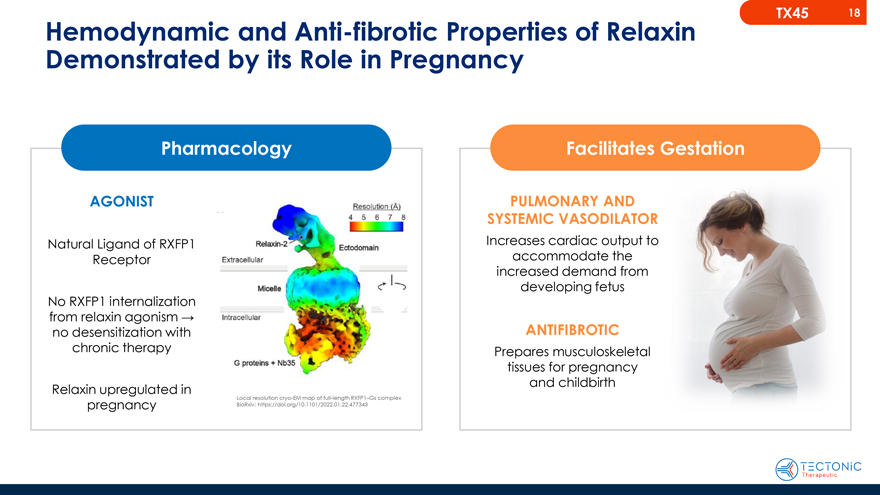
Hemodynamic and Anti-fibrotic Properties of Relaxin Demonstrated by its Role in Pregnancy Pharmacology Facilitates Gestation AGONIST PULMONARY AND SYSTEMIC VASODILATOR Natural Ligand of RXFP1 Increases cardiac output to Receptor accommodate the increased demand from developing fetus No RXFP1 internalizationANTIFIBROTIC Prepares musculoskeletal tissues for pregnancy and childbirth
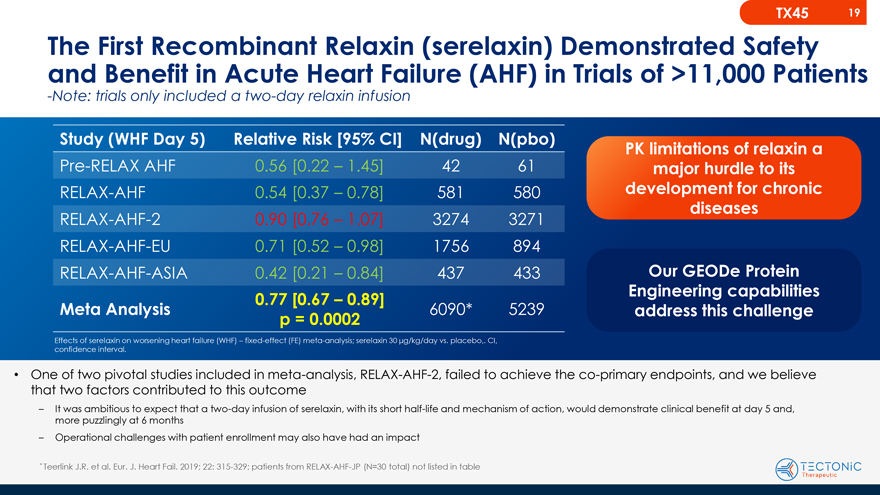
The First Recombinant Relaxin (serelaxin) Demonstrated Safety and Benefit in Acute Heart Failure (AHF) in Trials of >11,000 Patients -Note: trials only included a two-day relaxin infusion Study (WHF Day 5) Relative Risk [95% CI] N(drug) N(pbo) PK limitations of relaxin aPre-RELAX AHF 0.56 [0.22 – 1.45] 42 61 major hurdle to itsRELAX-AHF 0.54 [0.37 – 0.78] 581 580 development for chronic diseases RELAX-AHF-2 0.90 [0.76 – 1.07] 3274 3271 RELAX-AHF-EU 0.71 [0.52 – 0.98] 1756 894 RELAX-AHF-ASIA 0.42 [0.21 – 0.84] 437 433 Our GEODe Protein Engineering capabilities0.77 [0.67 – 0.89] Meta Analysis 6090* 5239 address this challenge p = 0.0002 Effects of serelaxin on worsening heart failure (WHF) – fixed-effect (FE) meta-analysis; serelaxiday vs. placebo,. CI, confidence interval. One of two pivotal studies included in meta-analysis, RELAX-AHF-2, failed to achieve the co-primary endpoints, and we believe that two factors contributed to this outcome – It was ambitious to expect that a two-day infusion of serelaxin, with its short half-life and mechanism of action, would demonstrate clinical benefit at day 5 and, more puzzlingly at 6 months – Operational challenges with patient enrollment may also have had an impact Teerlink J.R. et al. Eur. J. Heart Fail. 2019; 22: 315-329; patients from RELAX-AHF-JP (N=30 total) not listed in table
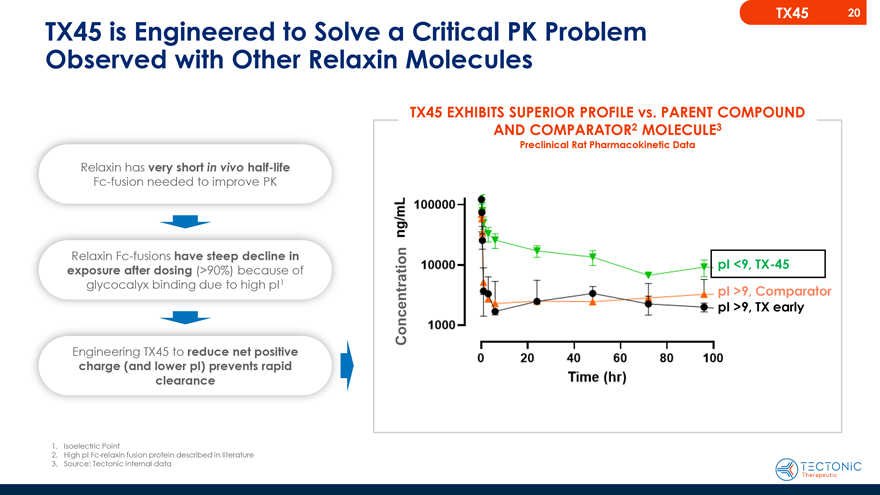
TX45 is Engineered to Solve a Critical PK Problem Observed with Other Relaxin Molecules TX45 EXHIBITS SUPERIOR PROFILE vs. PARENT COMPOUND AND COMPARATOR2 MOLECULE3 Preclinical Rat Pharmacokinetic Data Relaxin has very short in vivo half-life Fc-fusion needed to improve PKRelaxin Fc-fusions have steep decline in exposure after dosing (>90%) because of pI <9, TX-45 glycocalyx binding due to high pI1 pI >9, Comparator Concentration pI >9, TX early Engineering TX45 to reduce net positive charge (and lower pI) prevents rapid clearance1. Isoelectric Point 2. High pI Fc-relaxin fusion protein described in literature 3. Source: Tectonic internal data
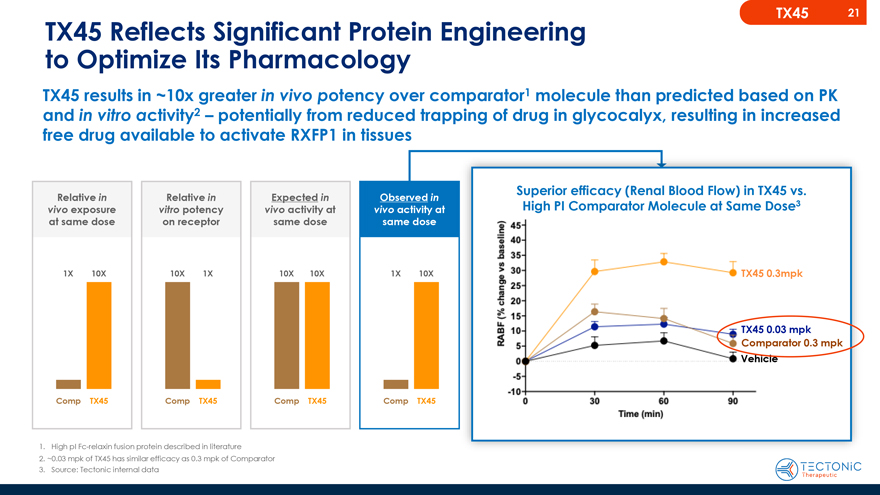
TX45 Reflects Significant Protein Engineering to Optimize Its Pharmacology TX45 results in ~10x greater in vivo potency over comparator1 molecule than predicted based on PK and in vitro activity2 – potentially from reduced trapping of drug in glycocalyx, resulting in increased free drug available to activate RXFP1 in tissuesSuperior efficacy (Renal Blood Flow) in TX45 vs.Relative in Relative in Expected in Observed inHigh PI Comparator Molecule at Same Dose3 vivo exposure vitro potency vivo activity at vivo activity at at same dose on receptor same dose same dose 1X 10X 10X 1X 10X 10X 1X 10X TX45 0.3mpk TX45 0.03 mpk Comparator 0.3 mpk Vehicle Comp TX45 Comp TX45 Comp TX45 Comp TX45 1. High pI Fc-relaxin fusion protein described in literature 2. ~0.03 mpk of TX45 has similar efficacy as 0.3 mpk of Comparator 3. Source: Tectonic internal data
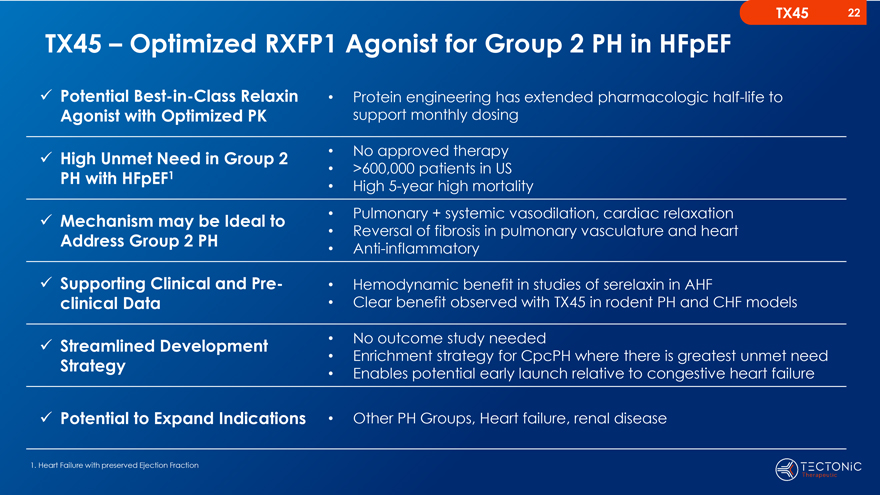
TX45 – Optimized RXFP1 Agonist for Group 2 PH in HFpEF Potential Best-in-Class Relaxin Protein engineering has extended pharmacologic half-life toAgonist with Optimized PK support monthly dosing HighNeed in No approved therapy Unmet Group 2 >600,000 patients in USPH with HFpEF1 High 5-year high mortality Mechanism may be Ideal to Pulmonary + systemic vasodilation, cardiac relaxation Reversal of fibrosis in pulmonary vasculature and heart Address Group 2 PH Anti- inflammatory Supporting Clinical and Pre- Hemodynamic benefit in studies of serelaxin in AHF clinical Data Clear benefit observed with TX45 in rodent PH and CHF models Streamlined Development No outcome study needed Enrichment strategy for CpcPH where there is greatest unmet need Strategy Enables potential early launch relative toheart failure congestive Potential to Expand Indications Other PH Groups, Heart failure, renal disease1. Heart Failure with preserved Ejection Fraction
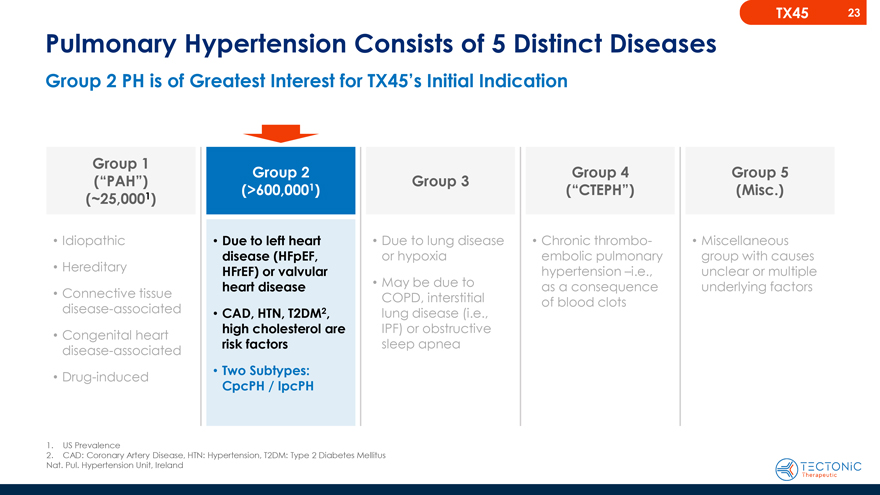
Pulmonary Hypertension Consists of 5 Distinct Diseases Group 2 PH is of Greatest Interest for TX45’s Initial Indication Group 1Group 2 Group 4 Group 5(“PAH”) 1 Group 3 1 (>600,000 ) (“CTEPH”) (Misc.) (~25,000 ) Idiopathic Due to left heart Due to lung disease Chronic thrombo- Miscellaneous disease (HFpEF, or hypoxia embolic pulmonary group with causes Hereditary HFrEF) or valvular hypertension –i.e., unclear or multiple heart disease May be due to as a consequence underlying factors Connective tissue COPD, interstitial of blood clots disease-associated CAD, HTN, T2DM2, lung disease (i.e., high cholesterol are IPF) or obstructive Congenital heart risk factors sleep apnea disease-associated Two Subtypes: Drug-induced CpcPH / IpcPH 1. US Prevalence 2. CAD: Coronary Artery Disease, HTN: Hypertension, T2DM: Type 2 Diabetes Mellitus Nat. Pul. Hypertension Unit, Ireland
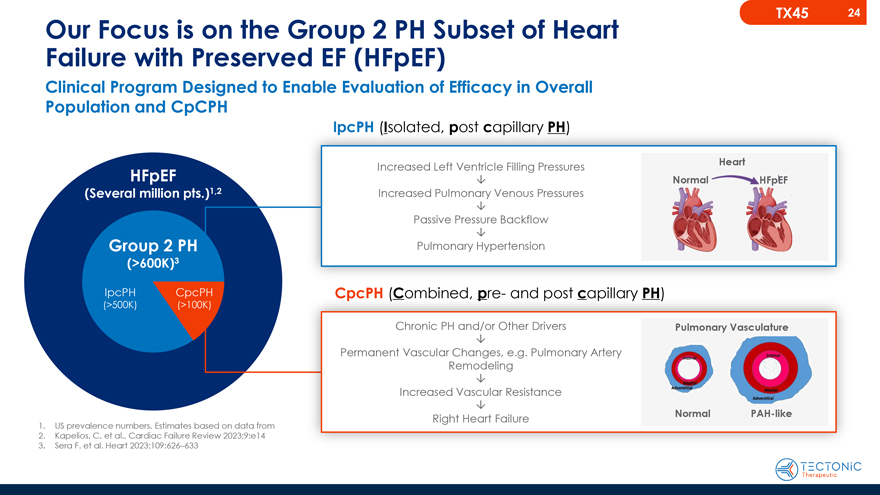
Our Focus is on the Group 2 PH Subset of Heart Failure with Preserved EF (HFpEF) Clinical Program Designed to Enable Evaluation of Efficacy in Overall Population and CpCPH IpcPH (Isolated, post capillary PH) HFpEF Increased Left Ventricle Filling PressuresHeart  Normal HFpEF (Several million pts.)1,2 Increased Pulmonary Venous Pressures  Passive Pressure Backflow  Group 2 PH Pulmonary Hypertension (>600K)3 IpcPH CpcPH CpcPH (Combined, pre- and post capillary PH) (>500K) (>100K) Chronic PH and/or Other DriversPulmonary Vasculature  Permanent Vascular Changes, e.g. Pulmonary Artery Remodeling  Increased Vascular Resistance Right Heart Failure Normal PAH-like 1. US prevalence numbers. Estimates based on data from 2. Kapelios, C. et al., Cardiac Failure Review 2023;9:e143. Sera F. et al. Heart 2023;109:626–633
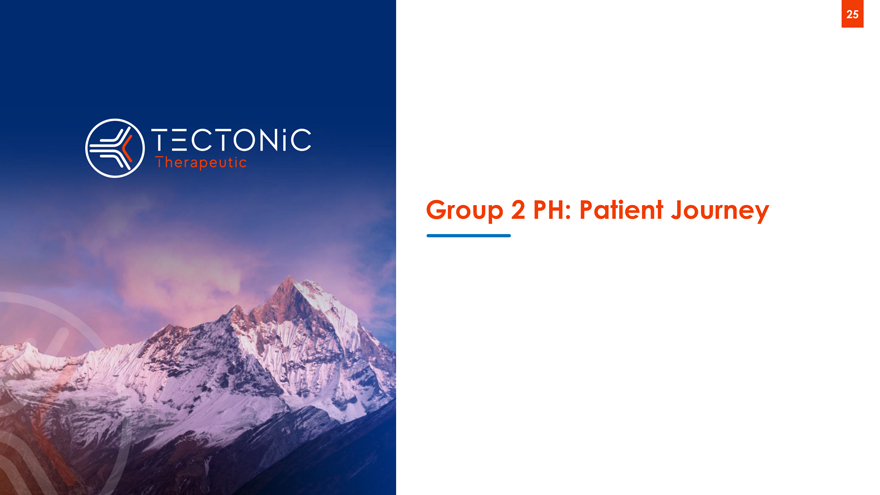
Group 2 PH: Patient Journey
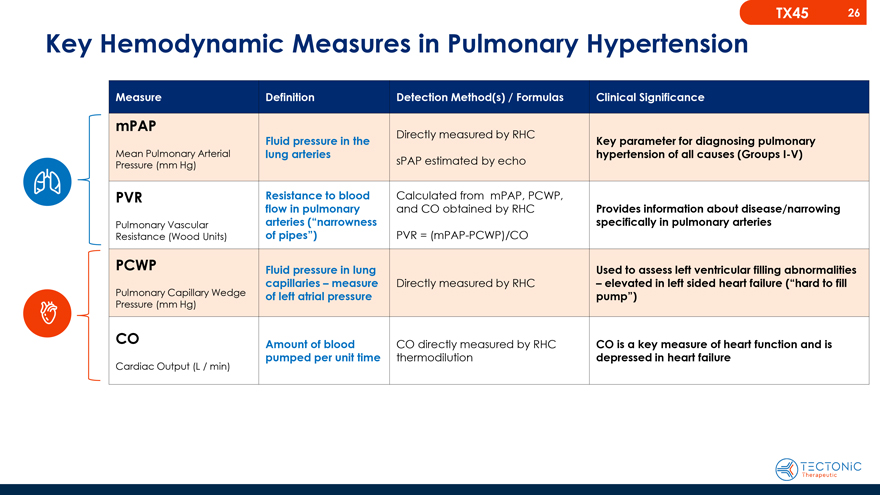
Key Hemodynamic Measures in Pulmonary Hypertension Measure Definition Detection Method(s) / Formulas Clinical Significance mPAPDirectly measured by RHC Fluid pressure in the Key parameter for diagnosing pulmonary Mean Pulmonary Arterial lung arteries hypertension of all causes (Groups I-V) Pressure (mm Hg) sPAP estimated by echo PVR Resistance to blood Calculated frommPAP, PCWP, flow in pulmonary and CO obtained by RHC Provides information about disease/narrowing Pulmonary Vascular arteries (“narrowness specifically in pulmonary arteries Resistance (Wood Units) of pipes”) PVR = (mPAP-PCWP)/CO PCWP Fluid pressure in lung Used to assess left ventricular filling abnormalitiesPulmonary Capillary Wedge capillaries – measure Directly measured by RHC – elevated in left sided heart failure (“hard to fill of left atrial pressure pump”) Pressure (mm Hg) CO Amount of blood CO directly measured by RHC CO is a key measure of heart function and is pumped per unit time thermodilution depressed in heart failure Cardiac Output (L / min)
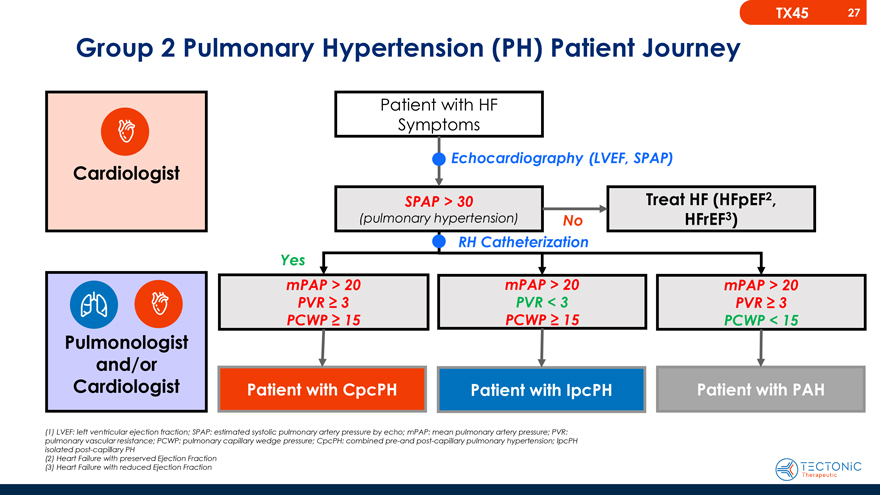
Group 2 Pulmonary Hypertension (PH) Patient JourneyPatient with HFSymptomsEchocardiography (LVEF, SPAP) CardiologistSPAP > 30 Treat HF (HFpEF2,(pulmonary hypertension) No HFrEF3)RH Catheterization Yes mPAP > 20 mPAP > 20 mPAP > 20 PVR 3 PVR < 3 PVR 3 PCWP 15 PCWP 15 PCWP < 15 Pulmonologist and/orCardiologist Patient with CpcPH Patient with IpcPH Patient with PAH(1) LVEF: left ventricular ejection fraction; SPAP: estimated systolic pulmonary artery pressure by echo; mPAP: mean pulmonary artery pressure; PVR: pulmonary vascular resistance; PCWP: pulmonary capillary wedge pressure; CpcPH: combined pre-and post-capillary pulmonary hypertension; IpcPH isolated post-capillary PH (2) Heart Failure with preserved Ejection Fraction (3) Heart Failure with reduced Ejection Fraction
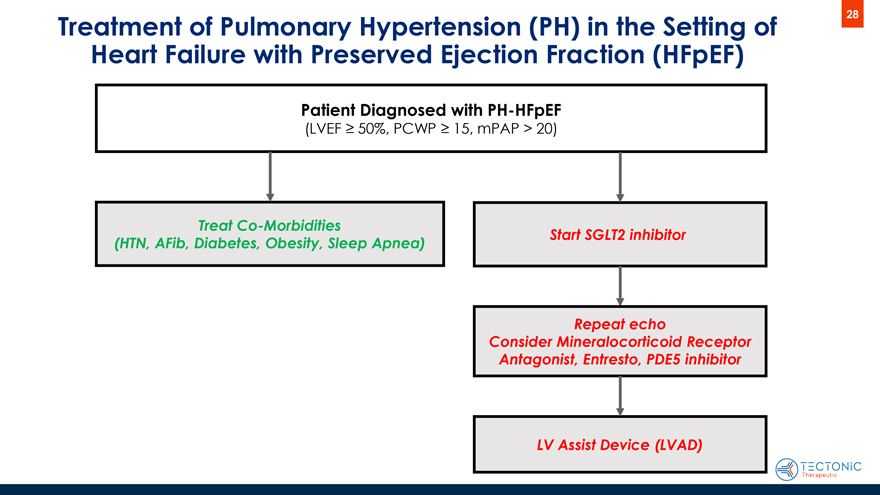
Treatment of Pulmonary Hypertension (PH) in the Setting of Heart Failure with Preserved Ejection Fraction (HFpEF) Patient Diagnosed with PH-HFpEF (LVEF ≥ 50%, PCWP ≥ 15, mPAP > 20) Treat Co-Morbidities Start SGLT2 inhibitor (HTN, AFib, Diabetes, Obesity, Sleep Apnea) Repeat echo Consider Mineralocorticoid Receptor Antagonist, Entresto, PDE5 inhibitor LV Assist Device (LVAD)
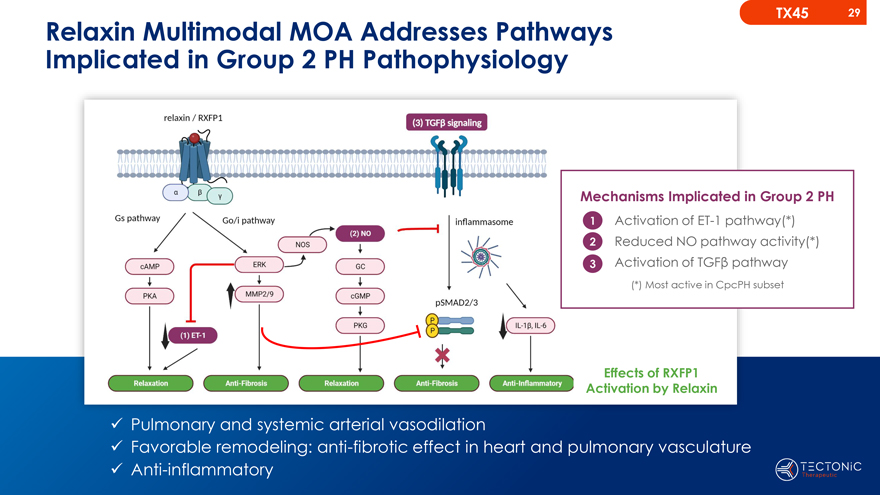
Relaxin Multimodal MOA Addresses Pathways Implicated in Group 2 PH Pathophysiology Mechanisms Implicated in Group 2 PH 1 Activation of ET-1 pathway(*) 2 Reduced NO pathway activity(*) 3 Activation of TGFβ pathway (*) Most active in CpcPH subset Effects of RXFP1 Activation by Relaxin Pulmonary and systemic arterial vasodilation Favorable remodeling: anti-fibrotic effect in heart and pulmonary vasculature Anti-inflammatory
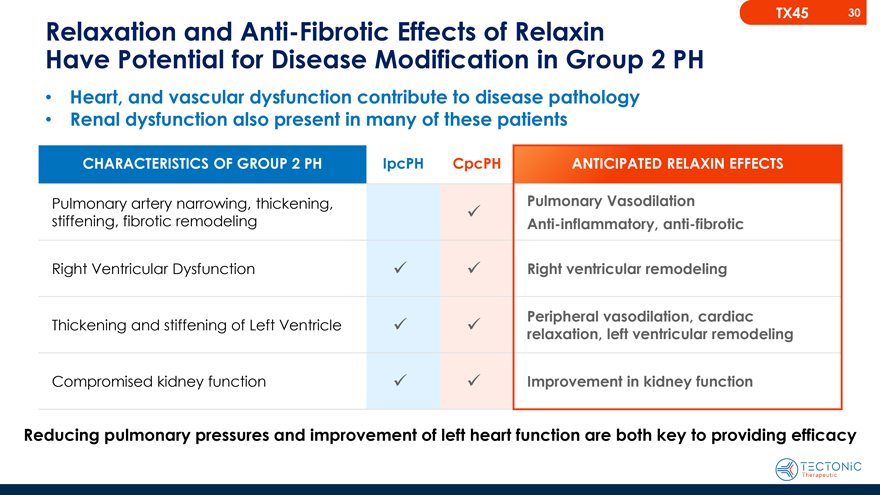
Relaxation and Anti-Fibrotic Effects of RelaxinHave Potential for Disease Modification in Group 2 PH Heart, and vascular dysfunction contribute to disease pathology Renal dysfunction also present in many of these patientsCHARACTERISTICS OF GROUP 2 PH IpcPH CpcPH ANTICIPATED RELAXIN EFFECTS Pulmonary artery narrowing, thickening, Pulmonary Vasodilation stiffening, fibrotic remodeling Anti-inflammatory, anti-fibroticRight Ventricular Dysfunction Right ventricular remodeling Peripheral vasodilation, cardiacThickening and stiffening of Left Ventricle relaxation, left ventricular remodeling Compromised kidney function Improvement in kidney functionReducing pulmonary pressures and improvement of left heart function are both key to providing efficacy
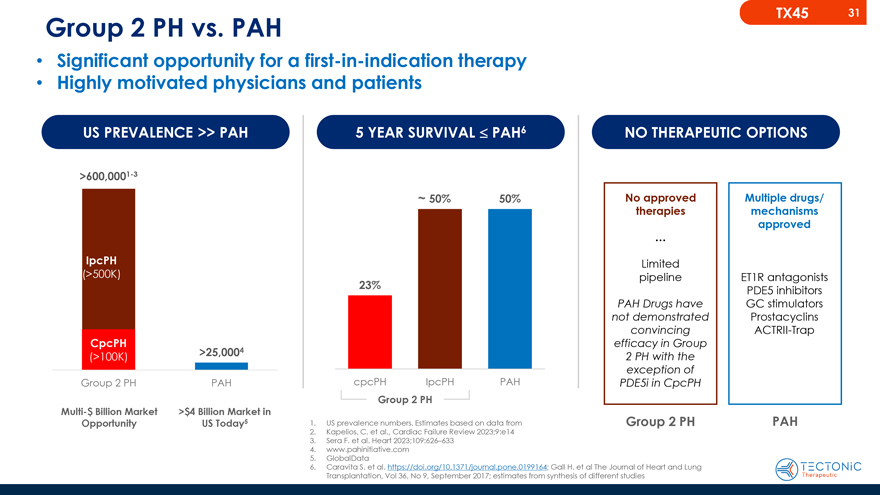
Group 2 PH vs. PAH Significant opportunity for a first-in-indication therapy Highly motivated physicians and patients US PREVALENCE >> PAH 5 YEAR SURVIVAL ï,£ PAH6 NO THERAPEUTIC OPTIONS >600,0001-3 ~ 50% 50% No approvedMultiple drugs/ therapies mechanisms approved … IpcPH Limited(>500K) 23% pipeline ET1R antagonists PDE5 inhibitors PAH Drugs have GC stimulators not demonstrated Prostacyclins convincing ACTRII-Trap CpcPH efficacy in Group>25,0004 (>100K) 2 PH with the exception of Group 2 PH PAH cpcPH IpcPH PAH PDE5i in CpcPH Group 2 PH Multi-$ Billion Market >$4 Billion Market inOpportunity US Today5 1. US prevalence numbers. Estimates based on data from Group 2 PH PAH 2. Kapelios, C. et al., Cardiac Failure Review 2023;9:e143. Sera F. et al. Heart 2023;109:626–633 4. www.pahinitiative.com 5. GlobalData 6. Caravita S. et al. https://doi.org/10.1371/journal.pone.0199164; Gall H. et al The Journal of Heart and Lung Transplantation, Vol 36, No 9, September 2017; estimates from synthesis of different studies
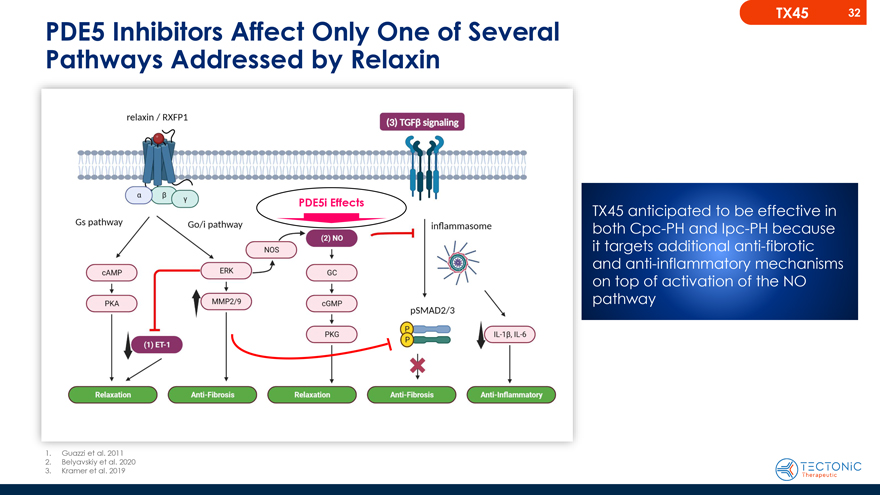
PDE5 Inhibitors Affect Only One of Several Pathways Addressed by Relaxin PDE5i Effects TX45 anticipated to be effective in both Cpc-PH and Ipc-PH because it targets additional anti-fibrotic and anti-inflammatory mechanisms on top of activation of the NO pathway 1. Guazzi et al. 20112. Belyavskiy et al. 2020 3. Kramer et al. 2019
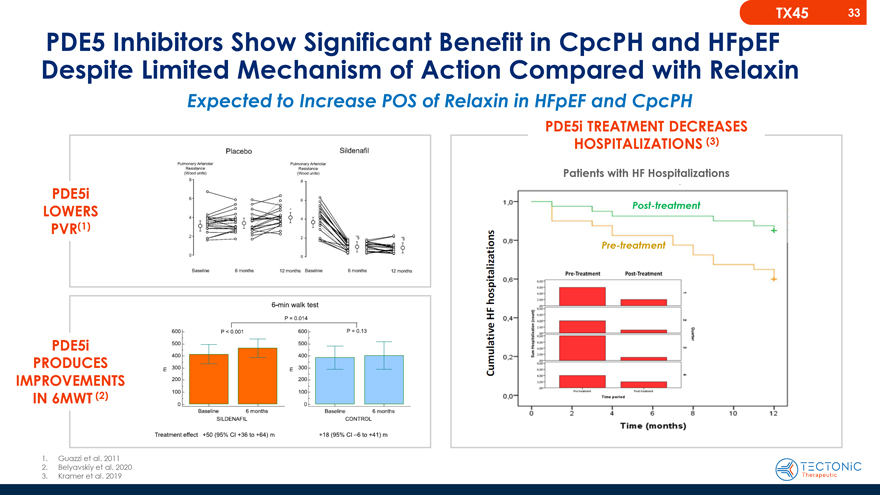
PDE5 Inhibitors Show Significant Benefit in CpcPH and HFpEFDespite Limited Mechanism of Action Compared with Relaxin Expected to Increase POS of Relaxin in HFpEF and CpcPH PDE5i TREATMENT DECREASES HOSPITALIZATIONS (3) Patients with HF Hospitalizations PDE5i Post-treatment LOWERS PVR(1) Pre-treatment PDE5i PRODUCESIMPROVEMENTS IN 6MWT (2)
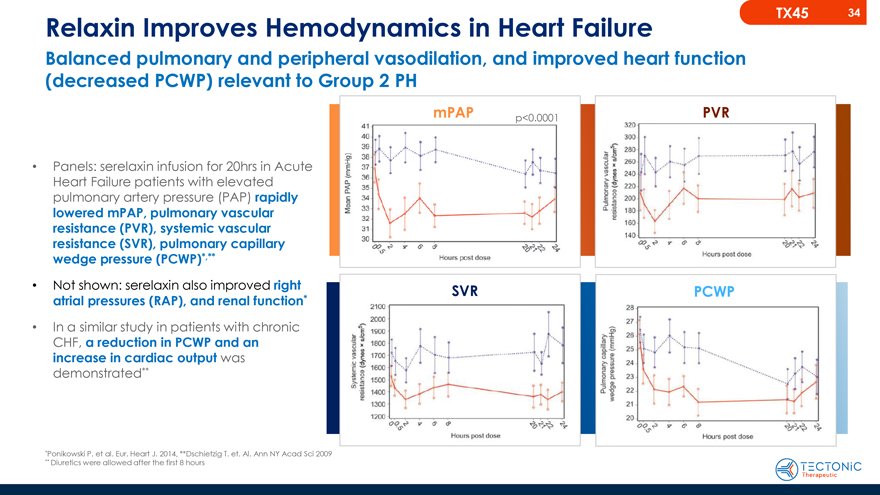
Relaxin Improves Hemodynamics in Heart Failure Balanced pulmonary and peripheral vasodilation, and improved heart function(decreased PCWP) relevant to Group 2 PH mPAP p<0.0001 PVR Panels: serelaxin infusion for 20hrs in Acute Heart Failure patients with elevated pulmonary artery pressure (PAP) rapidly lowered mPAP, pulmonary vascular resistance (PVR), systemic vascular resistance (SVR), pulmonary capillary wedge pressure (PCWP)*,** Not shown: serelaxin also improved right SVR PCWP atrial pressures (RAP), and renal function* In a similar study in patients with chronicCHF, a reduction in PCWP and an increase in cardiac output was demonstrated**
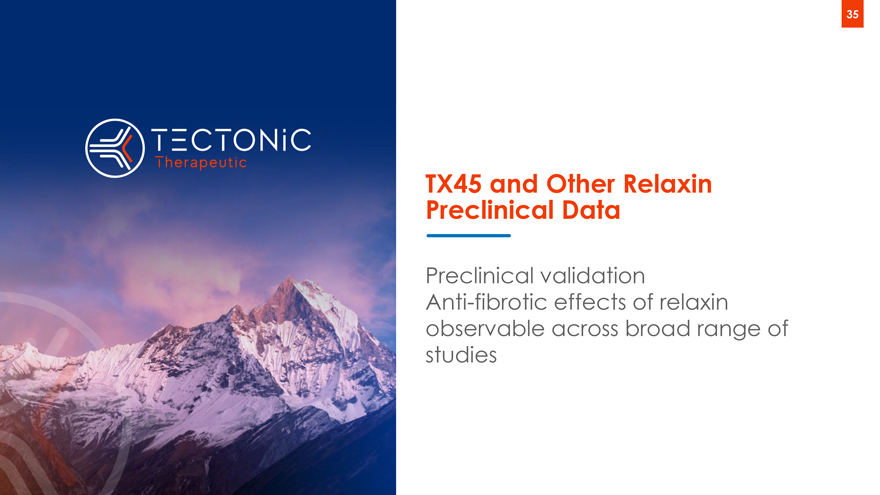
TX45 and Other Relaxin Preclinical Data Preclinical validation Anti-fibrotic effects of relaxin observable across broad range of studies
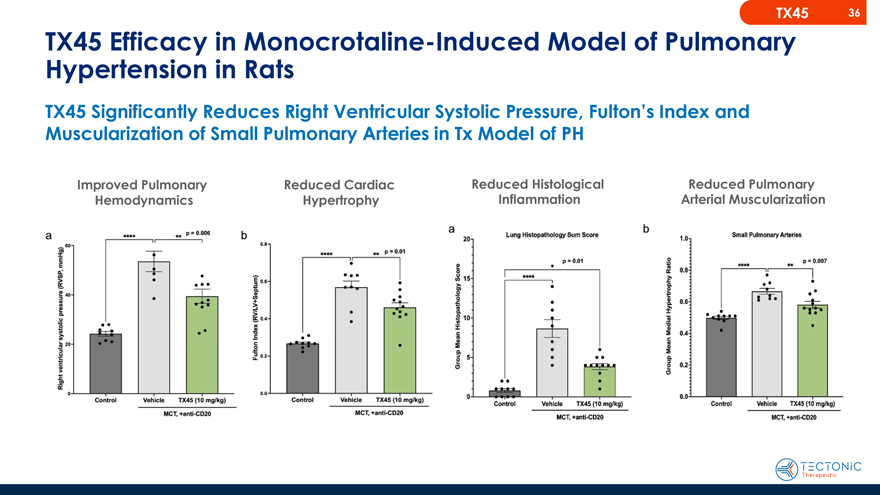
TX45 Efficacy in Monocrotaline-Induced Model of Pulmonary Hypertension in Rats TX45 Significantly Reduces Right Ventricular Systolic Pressure, Fulton’s Index and Muscularization of Small Pulmonary Arteries in Tx Model of PH Improved Pulmonary Reduced Cardiac Reduced Histological Reduced Pulmonary Hemodynamics Hypertrophy Inflammation Arterial Muscularization
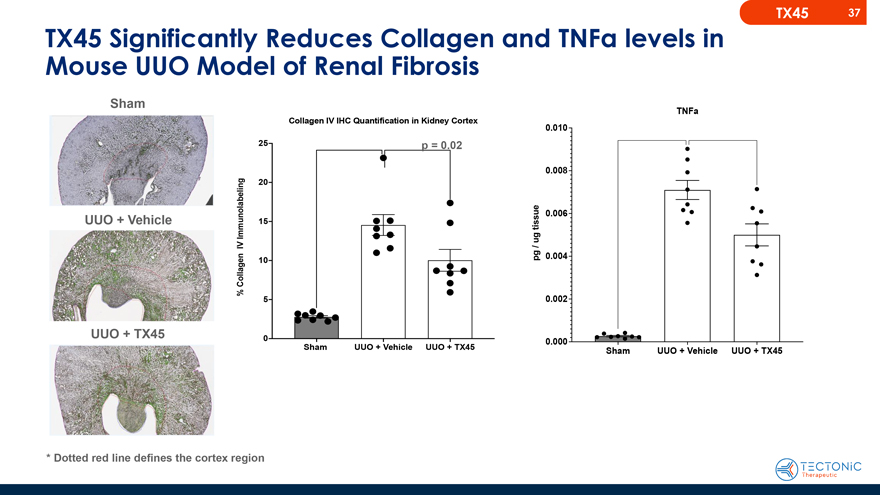
TX45 Significantly Reduces Collagen and TNFa levels in Mouse UUO Model of Renal Fibrosis Sham TNFa Collagen IV IHC Quantification in Kidney Cortex 0.010 25 p = 0.02 0.008 g20 beli n a unol 0.006 UUO + Vehicle 15 m mtissue I ug V / I ng 0.004 e 10 p la g C ol % 5 0.002 UUO + TX45 0 0.000 Sham UUO + Vehicle UUO + TX45 Sham UUO + Vehicle UUO + TX45 * Dotted red line defines the cortex region
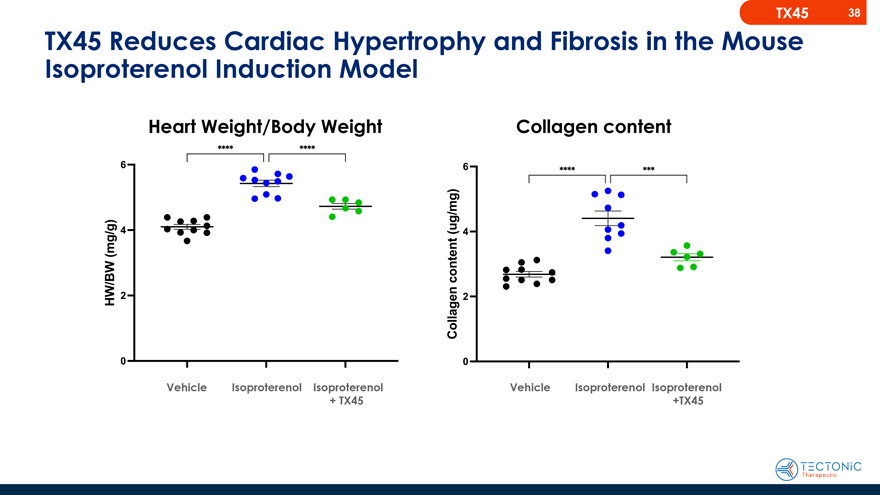
TX45 Reduces Cardiac Hypertrophy and Fibrosis in the Mouse Isoproterenol Induction Model Heart Weight/Body Weight Collagen content Vehicle Isoproterenol Isoproterenol Vehicle Isoproterenol Isoproterenol+ TX45 +TX45
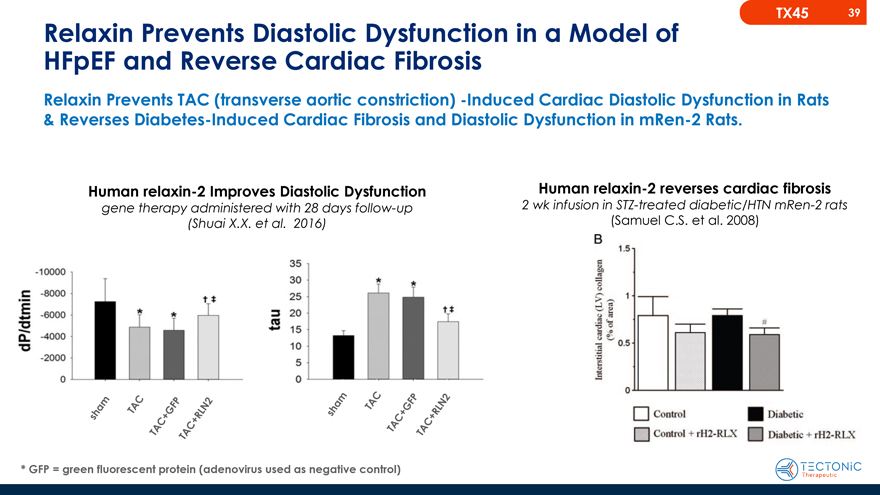
Relaxin Prevents Diastolic Dysfunction in a Model of HFpEF and Reverse Cardiac Fibrosis Relaxin Prevents TAC (transverse aortic constriction) -Induced Cardiac Diastolic Dysfunction in Rats & Reverses Diabetes-Induced Cardiac Fibrosis and Diastolic Dysfunction in mRen-2 Rats.Human relaxin-2 Improves Diastolic Dysfunction Human relaxin-2 reverses cardiac fibrosis gene therapy administered with 28 days follow-up 2 wk infusion in STZ-treated diabetic/HTN mRen-2 rats (Shuai X.X. et al.2016) (Samuel C.S. et al. 2008) * GFP = green fluorescent protein (adenovirus used as negative control)
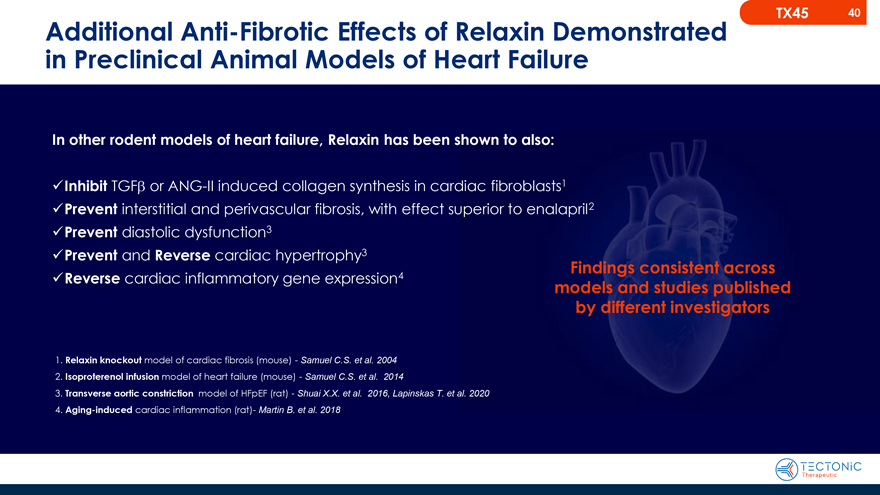
Additional Anti-Fibrotic Effects of Relaxin Demonstrated in Preclinical Animal Models of Heart Failure In other rodent models of heart failure, Relaxin has been shown to also: Inhibit TGFï¢ or ANG-II induced collagen synthesis in cardiac fibroblasts1 Prevent interstitial and perivascular fibrosis, with effect superior to enalapril2 Prevent diastolic dysfunction3 Prevent and Reverse cardiac hypertrophy3 Findings consistent across Reverse cardiac inflammatory gene expression4 models and studies published by different investigators 1. Relaxin knockout model of cardiac fibrosis (mouse)—Samuel C.S. et al. 2004 2. Isoproterenol infusion model of heart failure (mouse)—Samuel C.S. et al.2014 3. Transverse aortic constrictionmodel of HFpEF (rat)—Shuai X.X. et al.2016, Lapinskas T. et al. 2020 4. Aging-induced cardiac inflammation (rat)- Martin B. et al. 2018
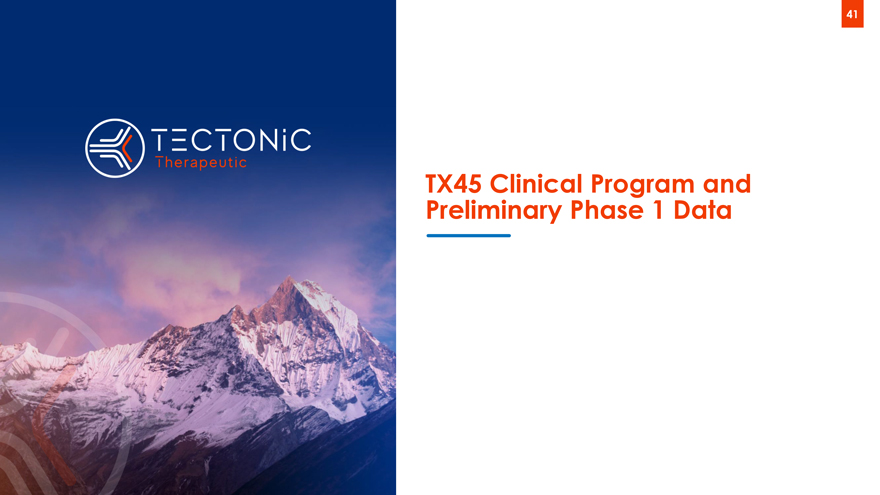
TX45 Clinical Program and Preliminary Phase 1 Data
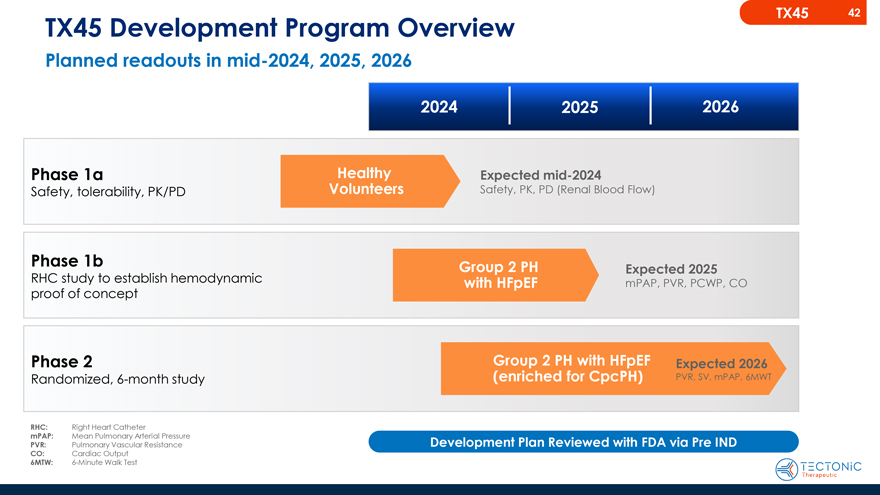
TX45 Development Program Overview Planned readouts in mid-2024, 2025, 2026 2024 2025 2026 Phase 1a Healthy Expected mid-2024 Safety, tolerability, PK/PD Volunteers Safety, PK, PD (Renal Blood Flow) Phase 1b Group 2 PHExpected 2025 RHC study to establish hemodynamic with HFpEF mPAP, PVR, PCWP, CO proof of concept Phase 2 Group 2 PH with HFpEF Expected 2026 Randomized, 6-month study (enriched for CpcPH) PVR, SV, mPAP, 6MWTRHC: Right Heart Catheter mPAP: Mean Pulmonary Arterial Pressure Development Plan Reviewed with FDA via Pre IND PVR: Pulmonary Vascular Resistance CO: Cardiac Output 6MTW: 6-Minute Walk Test
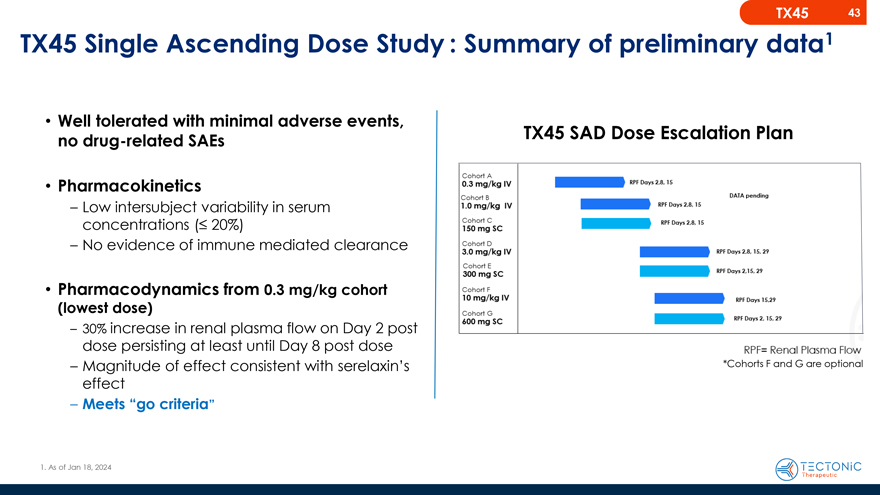
TX45 Single Ascending Dose Study : Summary of preliminary data1 Well tolerated with minimal adverse events,no drug-related SAEs TX45 SAD Dose Escalation Plan Pharmacokinetics – Low intersubject variability in serum concentrations (≤ 20%)– No evidence of immune mediated clearance Pharmacodynamics from 0.3 mg/kg cohort(lowest dose) – 30% increase in renal plasma flow on Day 2 post dose persisting at least until Day 8 post dose – Magnitude of effect consistent with serelaxin’s *Cohorts F and G are optional effect – Meets “go criteria”
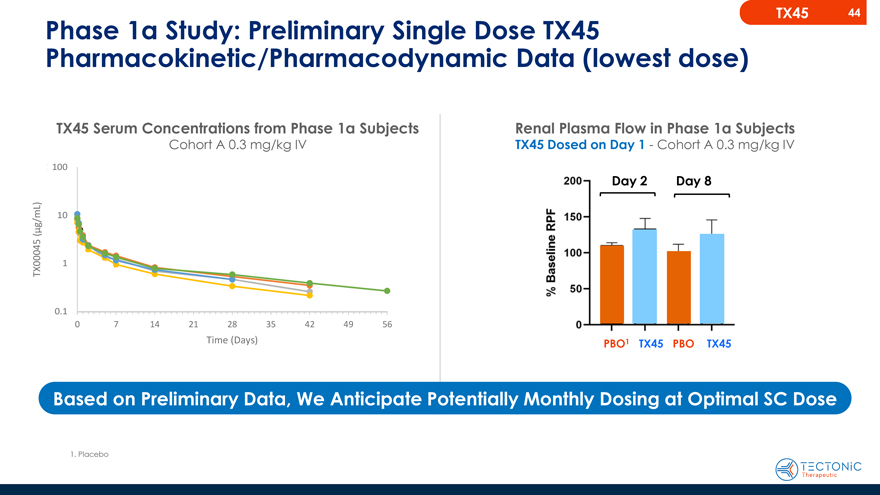
Phase 1a Study: Preliminary Single Dose TX45Pharmacokinetic/Pharmacodynamic Data (lowest dose) TX45 Serum Concentrations from Phase 1a Subjects Renal Plasma Flow in Phase 1a Subjects 150 mg SC TX45 Dosed on Day 1 - Cohort A 0.3 mg/kg IV100 Day 2Day 8 (µg/mL) 10 TX00045 1 0.1 0 7 14 Time (Days) PBO1 TX45 PBOTX45 Based on Preliminary Data, We Anticipate Potentially Monthly Dosing at Optimal SC Dose1. Placebo
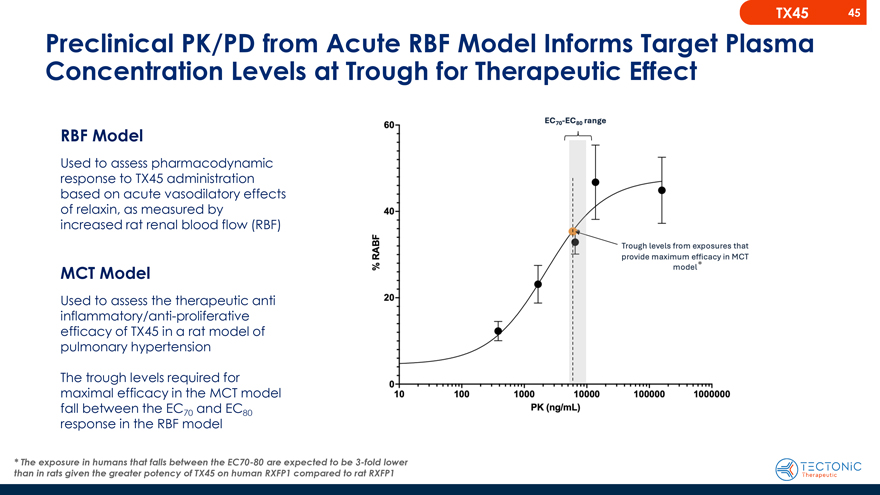
Preclinical PK/PD from Acute RBF Model Informs Target Plasma Concentration Levels at Trough for Therapeutic Effect RBF Model Used to assess pharmacodynamic response to TX45 administration based on acute vasodilatory effects of relaxin, as measured by increased rat renal blood flow (RBF) MCT Model * Used to assess the therapeutic anti inflammatory/anti-proliferative efficacy of TX45 in a rat model of pulmonary hypertension The trough levels required for maximal efficacy in the MCT model fall between the EC70 and EC80 response in the RBF model* The exposure in humans that falls between the EC70-80 are expected to be 3-fold lower than in rats given the greater potency of TX45 on human RXFP1 compared to rat RXFP1
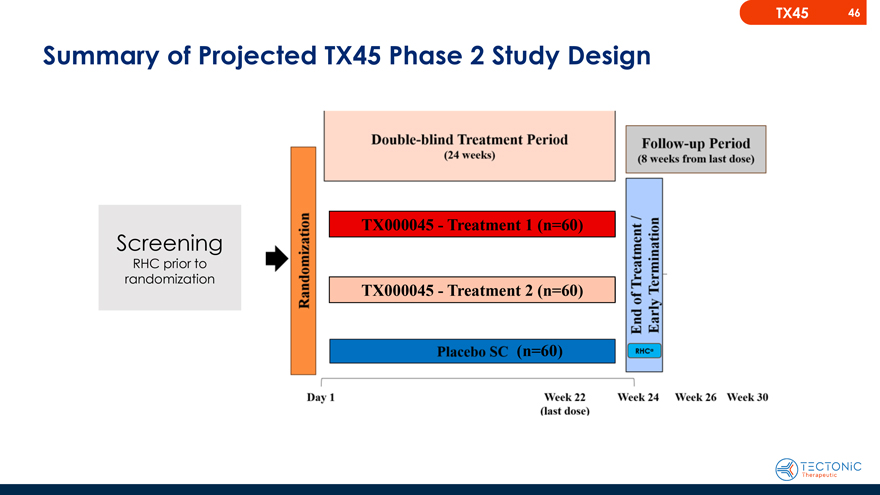
Summary of Projected TX45 Phase 2 Study Design TX000045—Treatment 1 (n=60) ScreeningRHC prior to randomization TX000045—Treatment 2 (n=60)(n=60)
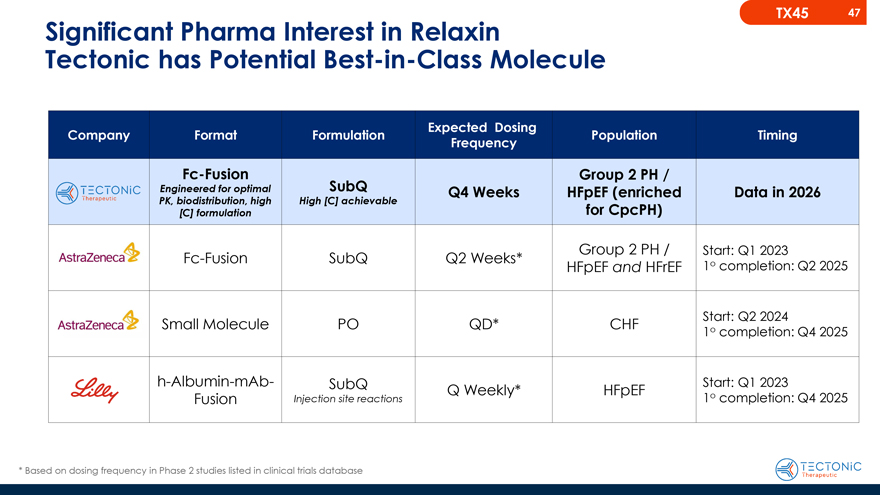
Significant Pharma Interest in Relaxin Tectonic has Potential Best-in-Class Molecule Expected Dosing Company Format Formulation Population Timing Frequency Fc-Fusion Group 2 PH /Engineered for optimal SubQ Q4 Weeks HFpEF (enriched Data in 2026 PK, biodistribution, high High [C] achievable [C] formulation for CpcPH) Group 2 PH / Start: Q1 2023 Fc-Fusion SubQ Q2 Weeks* o HFpEF and HFrEF 1 completion: Q2 2025 Start: Q2 2024 Small Molecule PO QD* CHF o 1 completion: Q4 2025 h-Albumin-mAb- SubQ Start: Q1 2023 Q Weekly* HFpEF o Fusion Injection site reactions 1 completion: Q4 2025
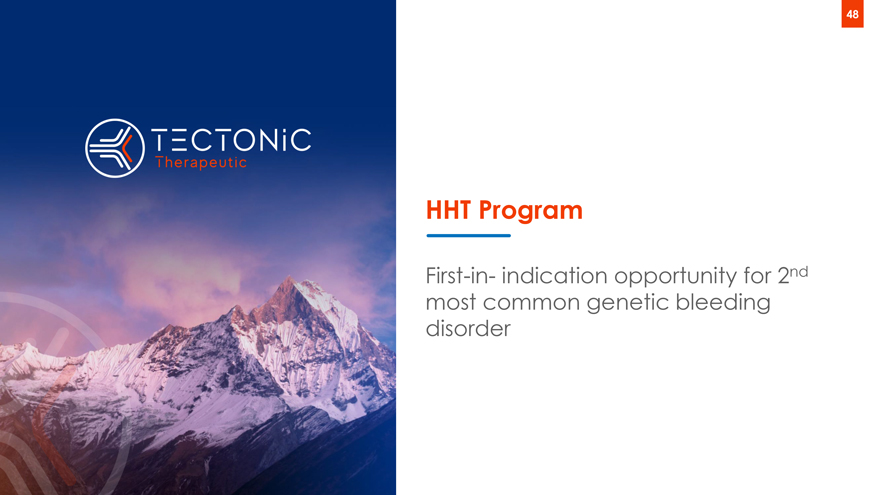
HHT Program First-in- indication opportunity for 2nd most common genetic bleeding disorder
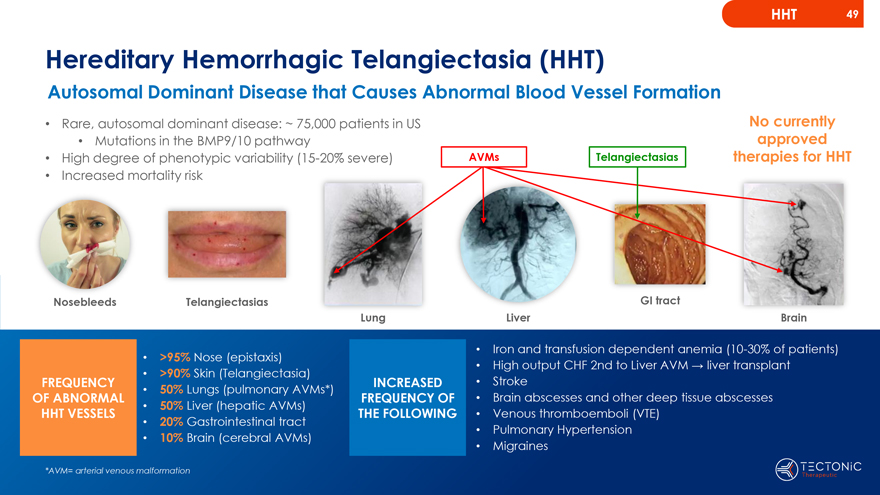
Hereditary Hemorrhagic Telangiectasia (HHT) Autosomal Dominant Disease that Causes Abnormal Blood Vessel Formation Rare, autosomal dominant disease: ~ 75,000 patients in US No currently Mutations in the BMP9/10 pathway approved High degree of phenotypic variability (15-20% severe) AVMs Telangiectasias therapies for HHT Increased mortality riskNosebleeds Telangiectasias GI tract Lung Liver Brain Iron and transfusion dependent anemia (10-30% of patients) >95% Nose (epistaxis) High output CHF 2nd to Liver AVM → liver transplant >90% Skin (Telangiectasia) FREQUENCY INCREASED Stroke 50% Lungs (pulmonary AVMs*) OF ABNORMAL FREQUENCY OF Brain abscesses and other deep tissue abscesses 50% Liver (hepatic AVMs) HHT VESSELS THE FOLLOWING Venous thromboemboli (VTE) 20% Gastrointestinal tract Pulmonary Hypertension 10% Brain (cerebral AVMs) Migraines *AVM= arterial venous malformation
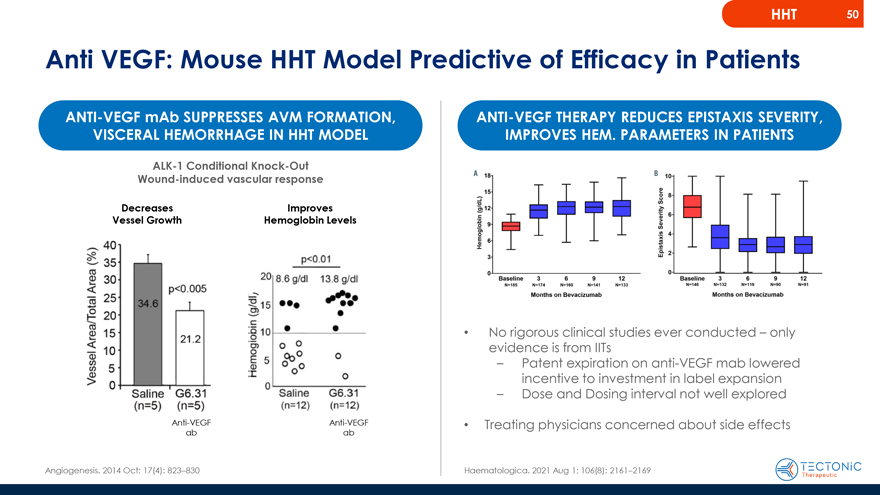
Anti VEGF: Mouse HHT Model Predictive of Efficacy in Patients ANTI-VEGF mAb SUPPRESSES AVM FORMATION, ANTI-VEGF THERAPY REDUCES EPISTAXIS SEVERITY, VISCERAL HEMORRHAGE IN HHT MODEL IMPROVES HEM. PARAMETERS IN PATIENTS ALK-1 Conditional Knock-Out Wound-induced vascular response Decreases Improves Vessel Growth Hemoglobin Levels No rigorous clinical studies ever conducted – only evidence is from IITs – Patent expiration on anti-VEGF mab lowered incentive to investment in label expansion – Dose and Dosing interval not well explored Treating physicians concerned about side effectsHaematologica. 2021 Aug 1; 106(8): 2161–2169
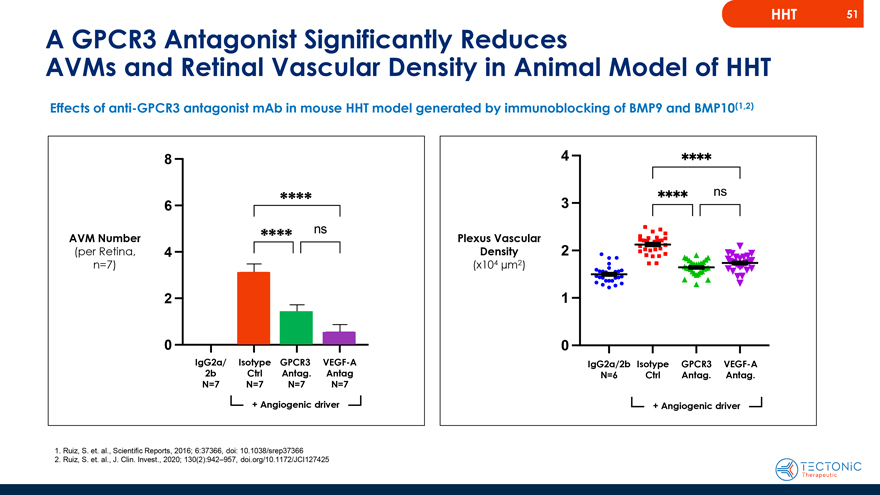
A GPCR3 Antagonist Significantly ReducesAVMs and Retinal Vascular Density in Animal Model of HHT Effects of anti-GPCR3 antagonist mAb in mouse HHT model generated by immunoblocking of BMP9 and BMP10(1,2) 7 ) 8 n = na, **** et i 6 r ns AVM Number per **** Plexus Vascular(per Retina, ( 4 Density n=7)ber (x104 µm2) um 2 n M AV 0 IgG2a/ Isotype GPCR3 VEGF-A IgG2a/2b Isotype GPCR3 VEGF-A b 2 1 1 / 22b 4Ctrl 5 Antag. . 3 Antag N=6 Ctrl Antag. Antag. a 9 3 6 2 N=7 X N=7 1 N=7 N=7 T X G G T I g + Angiogenic driver + Angiogenic driver1. Ruiz, S. et. al., Scientific Reports, 2016; 6:37366, doi: 10.1038/srep37366 2. Ruiz, S. et. al., J. Clin. Invest., 2020; 130(2):942–957, doi.org/10.1172/JCI127425
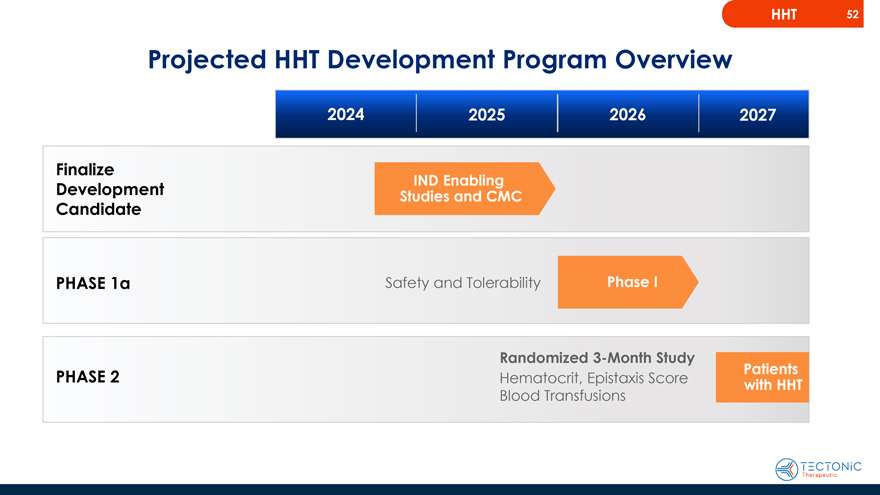
Projected HHT Development Program Overview 2024 2025 2026 2027 FinalizeIND Enabling Development Studies and CMC Candidate PHASE 1a Safety and Tolerability Phase I Randomized 3-Month Study PHASE 2 PatientsHematocrit, Epistaxis Score with HHT Blood Transfusions
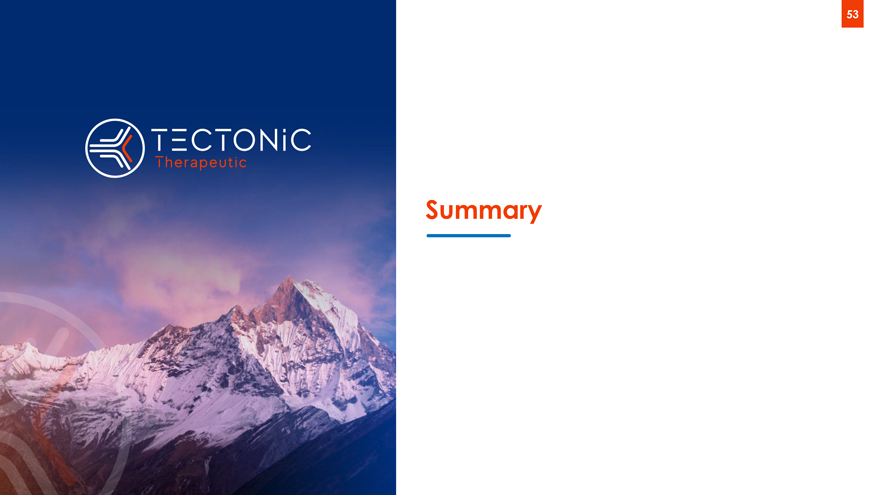
Summary
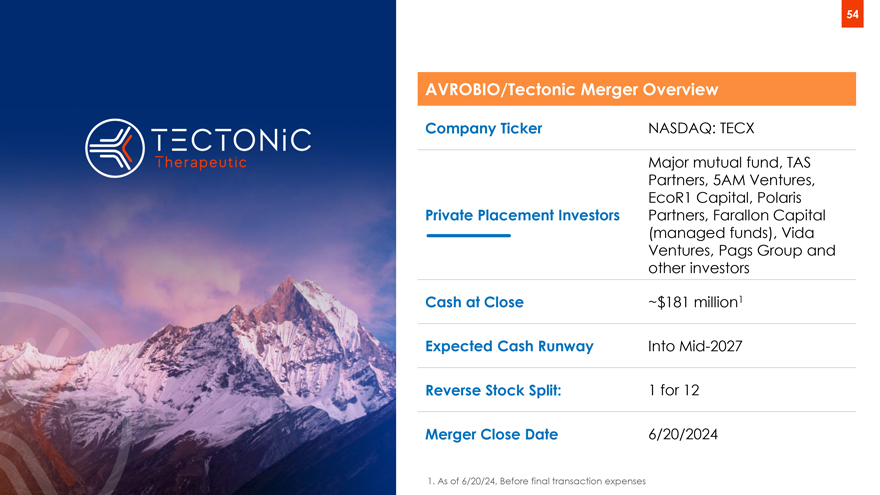
AVROBIO/Tectonic Merger Overview Company Ticker NASDAQ: TECX Major mutual fund, TAS Partners, 5AM Ventures, EcoR1 Capital, PolarisPrivate Placement Investors Partners, Farallon Capital(managed funds), Vida Ventures, Pags Group and other investors Cash at Close ~$181 million1 Expected Cash Runway Into Mid-2027 Reverse Stock Split: 1 for 12 Merger Close Date 6/20/2024 1. As of 6/20/24, Before final transaction expenses
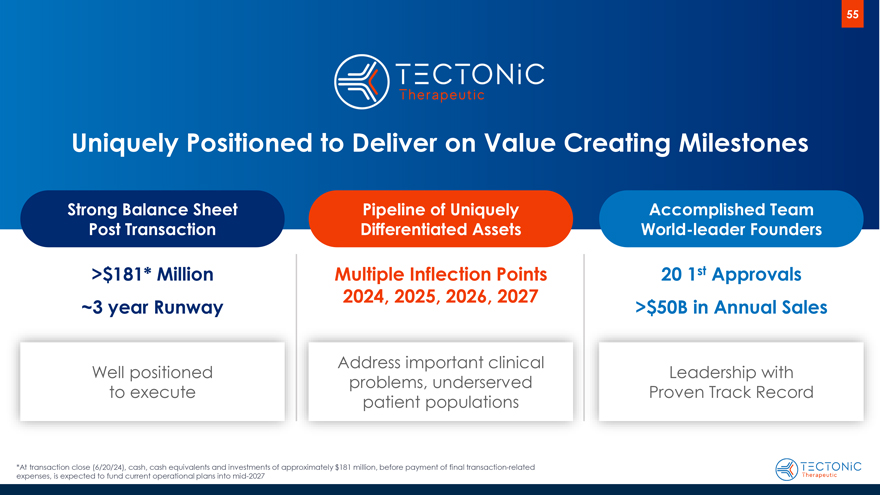
Uniquely Positioned to Deliver on Value Creating Milestones Strong Balance Sheet Pipeline of Uniquely Accomplished Team Post Transaction Differentiated Assets World-leader Founders >$181* Million Multiple Inflection Points 20 1st Approvals 2024, 2025, 2026, 2027 ~3 year Runway >$50B in Annual Sales Address important clinicalWell positioned Leadership with problems, underserved to execute Proven Track Record patient populations *At transaction close (6/20/24), cash, cash equivalents and investments of approximately $181 million, before payment of final transaction-related expenses, is expected to fund current operational plans into mid-2027
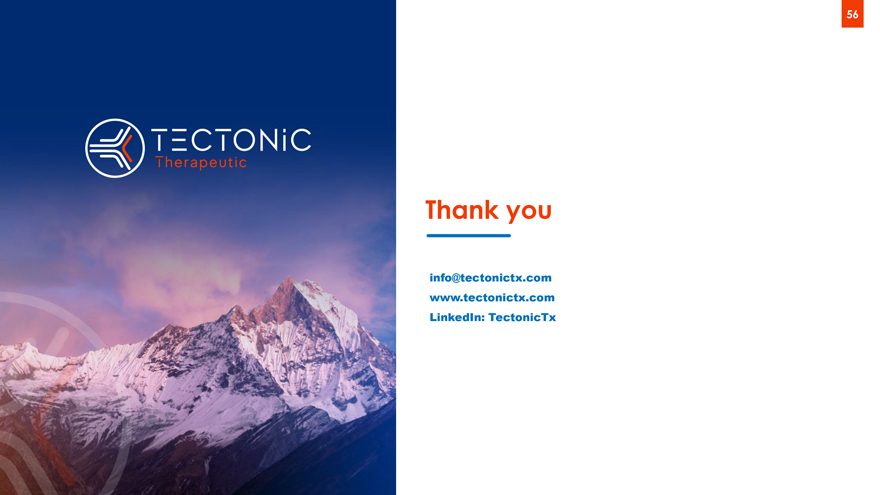
Thank you info@tectonictx.com www.tectonictx.com LinkedIn: TectonicTx